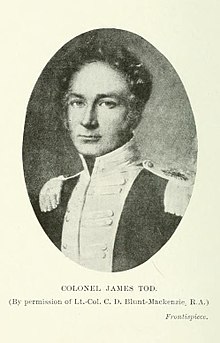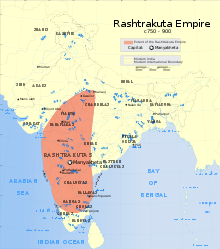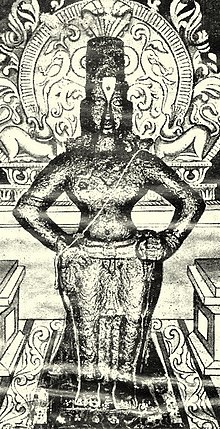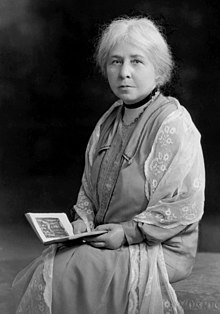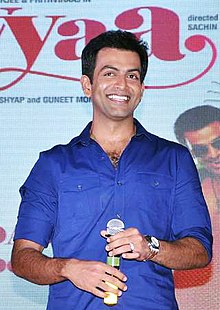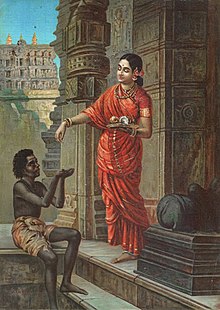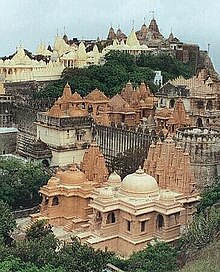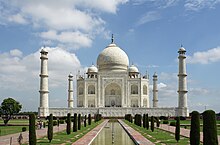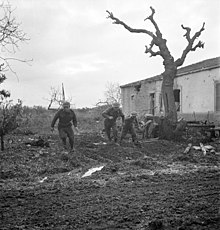Portal:India
Portal maintenance status: (June 2018)
|
Introduction


India, officially the Republic of India, is a country in South Asia. It is the seventh-largest country by area; the most populous country from June 2023 onwards; and since its independence in 1947, the world's most populous democracy. Bounded by the Indian Ocean on the south, the Arabian Sea on the southwest, and the Bay of Bengal on the southeast, it shares land borders with Pakistan to the west; China, Nepal, and Bhutan to the north; and Bangladesh and Myanmar to the east. In the Indian Ocean, India is near Sri Lanka and the Maldives; its Andaman and Nicobar Islands share a maritime border with Thailand, Myanmar, and Indonesia. (Full article...)
 Featured article – show another
Featured article – show another
-
Image 1

Nyctibatrachus major, the Malabar night frog, large wrinkled frog, or Boulenger's narrow-eyed frog is a species of frog in the family Nyctibatrachidae, commonly known as the robust frogs. It was described in 1882 by the zoologist George Albert Boulenger, and is the type species of the genus Nyctibatrachus. It is a large frog for its genus, with an adult snout–vent length of 31.5–52.0 mm (1.24–2.05 in) for males and 43.7–54.2 mm (1.72–2.13 in) for females. It is mainly brownish to greyish in colour, with a dark greyish-brown upperside, a greyish-white underside, and light grey sides. It also has a variety of grey or brown markings. When preserved in ethanol, it is mostly greyish-brown to grey, with whitish sides. Sexes can be told apart by the presence of the femoral glands (bulbous glands near the inner thigh) in males.
The species is endemic to the Western Ghats mountain range of India, where it is found in Kerala, Tamil Nadu, and Karnataka. Adults inhabit fast-moving forest streams at elevations of up to 900 m (3,000 ft) and have highly specific habitat requirements. Adults are mostly found in or near water and are nocturnal; subadults can be found during both the night and day. Its diet mainly consists of other frogs and insect larvae. Over a period of several days or weeks, females lay multiple small clutches of eggs on leaves and rocks overhanging water; tadpoles drop into the water below on hatching. The species is currently classified as being vulnerable on the IUCN Red List owing to its small and fragmented range and ongoing habitat degradation. Threats to the species include habitat loss, increased human presence near the streams it inhabits, and possibly nitrate pollution caused by fertiliser overuse. (Full article...) -
Image 2
Arthur Edward Jeune Collins (18 August 1885 – 11 November 1914) was an English cricketer and soldier. He held, for 116 years, the record of highest score in cricket: as a 13-year-old schoolboy, he scored 628 not out over four afternoons in June 1899. Collins's record-making innings drew a large crowd and increasing media interest; spectators at the Old Cliftonian match being played nearby were drawn away to watch the junior school house cricket match in which Collins was playing. Despite this achievement, Collins never played first-class cricket. Collins's 628 not out stood as the record score until January 2016 when an Indian boy, Pranav Dhanawade, scored 1009 in a single innings.
Collins joined the British Army in 1902 and studied at the Royal Military Academy, Woolwich, before becoming an officer in the Royal Engineers. He served in France during the First World War, where he was killed in action in 1914 during the First Battle of Ypres. Collins had been mentioned in despatches and also represented the Royal Military Academy at cricket and rugby union. (Full article...) -
Image 3
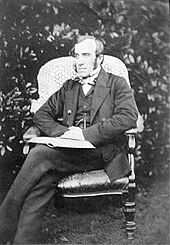
Monier Williams, elected as the second Boden Professor of Sanskrit in 1860; this photograph was taken by Lewis Carroll.
The election in 1860 for the position of Boden Professor of Sanskrit at the University of Oxford was a competition between two candidates offering different approaches to Sanskrit scholarship. One was Monier Williams, an Oxford-educated Englishman who had spent 14 years teaching Sanskrit to those preparing to work in British India for the East India Company. The other, Max Müller, was a German-born lecturer at Oxford specialising in comparative philology, the science of language. He had spent many years working on an edition of the Rig Veda (an ancient collection of Vedic Sanskrit hymns) and had gained an international reputation for his scholarship. Williams, in contrast, worked on later material and had little time for the "continental" school of Sanskrit scholarship that Müller exemplified. Williams regarded the study of Sanskrit as a means to an end, namely the conversion of India to Christianity. In Müller's opinion, his own work, while it would assist missionaries, was also valuable as an end in itself.
The election came at a time of public debate about British rule in India in the wake of the Indian Rebellion of 1857. Opinions were divided on whether greater efforts should be made to convert India or whether to remain sensitive to local culture and traditions. Both men battled for the votes of the electorate (the Convocation of the university, consisting of over 3,700 graduates) through manifestos and newspaper correspondence. Williams laid great stress in his campaign on the intention of the original founder of the chair, that the holder should assist in converting India through dissemination of the Christian scriptures. Müller's view was that his work on the Rig Veda was of great value for missionary work, and published testimonials accordingly. He also wanted to teach wider subjects such as Indian history and literature to assist missionaries, scholars, and civil servants – a proposal that Williams criticised as not in accordance with the original benefactor's wishes. The rival campaigns took out newspaper advertisements and circulated manifestos, and different newspapers backed each man. Although generally regarded as superior to Williams in scholarship, Müller had the double disadvantage (in the eyes of some) of being German and having liberal Christian views. Some of the newspaper pronouncements in favour of Williams were based on a claimed national interest of having an Englishman as Boden professor to assist with the work of governing and converting India. (Full article...) -
Image 4
The black stork (Ciconia nigra) is a large bird in the stork family Ciconiidae. It was first described by Carl Linnaeus in the 10th edition of his Systema Naturae. Measuring on average 95 to 100 cm (37 to 39 in) from beak tip to end of tail with a 145-to-155 cm (57-to-61 in) wingspan, the adult black stork has mainly black plumage, with white underparts, long red legs and a long pointed red beak. A widespread but uncommon species, it breeds in scattered locations across Europe (predominantly in Portugal and Spain, and central and eastern parts), and east across the Palearctic to the Pacific Ocean. It is a long-distance migrant, with European populations wintering in tropical Sub-Saharan Africa, and Asian populations in the Indian subcontinent. When migrating between Europe and Africa, it avoids crossing broad expanses of the Mediterranean Sea and detours via the Levant in the east, the Strait of Sicily in the center, or the Strait of Gibraltar in the west. An isolated non-migratory population lives in Southern Africa.
Unlike the closely related white stork, the black stork is a shy and wary species. It is seen singly or in pairs, usually in marshy areas, rivers or inland waters. It feeds on amphibians, small fish and insects, generally wading slowly in shallow water stalking its prey. Breeding pairs usually build nests in large forest trees—most commonly deciduous but also coniferous—which can be seen from long distances, as well as on large boulders, or under overhanging ledges in mountainous areas. The female lays two to five greyish-white eggs, which become soiled over time in the nest. Incubation takes 32 to 38 days, with both sexes sharing duties, and fledging takes 60 to 71 days. (Full article...) -
Image 5Parinda (transl. Bird) is a 1989 Indian Hindi-language crime thriller film directed, produced and distributed by Vidhu Vinod Chopra. The film stars Jackie Shroff, Anil Kapoor, Nana Patekar and Madhuri Dixit. The story and scenario were written by Chopra, while Shiv Kumar Subramaniam and Imtiyaz Husain wrote the screenplay and dialogues, respectively. R. D. Burman composed the music and Khurshid Hallauri wrote the lyrics. Binod Pradhan served as the film's cinematographer and Renu Saluja was its editor.
Parinda follows Kishan (Shroff), who works for the underworld chieftain Anna (Patekar). Kishan's brother Karan (Kapoor) returns home after completing his studies in the United States. The two brothers are caught on different sides of a gang war after Karan decides to avenge his friend's death by Anna. (Full article...) -
Image 6Lage Raho Munna Bhai (pronounced [ləˈɡeː rəˈɦoː mʊnːaːˈbʱaːi] ⓘ; translation: Keep Going, Munna Bro) is a 2006 Indian Hindi-language satirical comedy drama film written, edited and directed by Rajkumar Hirani, who also co-wrote the screenplay with Abhijat Joshi, and produced by Vidhu Vinod Chopra under the banner Vinod Chopra Films. A sequel to Munna Bhai M.B.B.S. (2003), the film is the second installment of the Munna Bhai series. Sanjay Dutt and Arshad Warsi reprised their roles as the titular Munna Bhai and Circuit, respectively. New additions to the cast include Vidya Balan, Dilip Prabhavalkar and Dia Mirza, while several actors from the original, notably Jimmy Sheirgill and Boman Irani, appear in new roles.
In this film, the eponymous lead character, a don in the Mumbai underworld, begins to see visions of Mahatma Gandhi. Through his interactions with Gandhi, he begins to practice what he refers to as "Gandhigiri" (a neologism for "Gandhism") to help ordinary people solve their problems. (Full article...) -
Image 7

Virupaksha temple at Hampi, the sacred centre at Vijayanagara, the royal capital
Vijayanagara literature in Kannada is the body of literature composed in the Kannada language of South India during the ascendancy of the Vijayanagara Empire which lasted from the 14th through the 16th century. The Vijayanagara empire was established in 1336 by Harihara I and his brother Bukka Raya I. Although it lasted until 1664, its power declined after a major military defeat by the Shahi Sultanates in the battle of Talikota in 1565. The empire is named after its capital city Vijayanagara, whose ruins surround modern Hampi, now a World Heritage Site in Karnataka.
Kannada literature during this period consisted of writings relating to the socio-religious developments of the Veerashaiva and Vaishnava faiths, and to a lesser extent to that of Jainism. Writing on secular topics was popular throughout this period. Authorship of these writings was not limited to poets and scholars alone. Significant literary contributions were made by members of the royal family, their ministers, army commanders of rank, nobility and the various subordinate rulers. In addition, a vast body of devotional folk literature was written by musical bards, mystics and saint-poets, influencing society in the empire. Writers of this period popularised use of the native metres: shatpadi (six-line verse), sangatya (compositions meant to be sung to the accompaniment of a musical instrument), and tripadi (three-line verse). (Full article...) -
Image 8The frontispiece of the 1920 edition of Tod's Annals and Antiquities of Rajast'han
Lieutenant-Colonel James Tod (20 March 1782 – 18 November 1835) was an officer of the British East India Company and an Oriental scholar. He combined his official role and his amateur interests to create a series of works about the history and geography of India, and in particular the area then known as Rajputana that corresponds to the present day state of Rajasthan, and which Tod referred to as Rajast'han.
Tod was born in London and educated in Scotland. He joined the East India Company as a military officer and travelled to India in 1799 as a cadet in the Bengal Army. He rose quickly in rank, eventually becoming captain of an escort for an envoy in a Sindian royal court. After the Third Anglo-Maratha War, during which Tod was involved in the intelligence department, he was appointed Political Agent for some areas of Rajputana. His task was to help unify the region under the control of the East India Company. During this period Tod conducted most of the research that he would later publish. Tod was initially successful in his official role, but his methods were questioned by other members of the East India Company. Over time, his work was restricted and his areas of oversight were significantly curtailed. In 1823, owing to declining health and reputation, Tod resigned his post as Political Agent and returned to England. (Full article...) -
Image 9Aitraaz (transl. Objection) is a 2004 Indian Hindi-language romantic thriller film directed by Abbas–Mustan and produced by Subhash Ghai. It stars Akshay Kumar, Priyanka Chopra and Kareena Kapoor.
Aitraaz tells the story of a man accused of sexual harassment by his female superior, and was released on 12 November 2004 to positive reviews. Chopra received widespread critical acclaim for her performance. Loosely based on the 1994 film Disclosure, the film was a major commercial success grossing ₹260 million at the box office against a budget of ₹110 million, and has been noted for its bold subject of male sexual harassment. (Full article...) -
Image 10
Sonam Kapoor Ahuja (pronounced [soːnəm kəˈpuːr]; born 9 June 1985) is an Indian actress who works in Hindi films. She has received several awards, including a National Film Award and a Filmfare Award. One of the highest-paid Hindi film actresses in the 2010s, Kapoor appeared in Forbes India's Celebrity 100 list from 2012 to 2016.
Kapoor, the daughter of actor Anil Kapoor, began her career as an assistant director on filmmaker Sanjay Leela Bhansali's 2005 film Black. She made her acting debut in Bhansali's romantic drama Saawariya (2007), a box office flop, and had her first commercial success with the romantic comedy I Hate Luv Storys (2010). This was followed by a series of commercial failures and repetitive roles, which garnered her negative reviews. The 2013 box office hit Raanjhanaa marked a turning point in Kapoor's career, garnering her praise and Best Actress nominations at several award ceremonies. (Full article...) -
Image 11
The Western Chalukya Empire (/tʃəˈluːkjə/ chə-LOO-kyə) ruled most of the western Deccan, South India, between the 10th and 12th centuries. This Kannada-speaking dynasty is sometimes called the Kalyani Chalukya after its regal capital at Kalyani, today's Basavakalyan in the modern Bidar district of Karnataka state, and alternatively the Later Chalukya from its theoretical relationship to the 6th-century Chalukya dynasty of Badami. The dynasty is called Western Chalukyas to differentiate from the contemporaneous Eastern Chalukyas of Vengi, a separate dynasty. Before the rise of these Chalukyas, the Rashtrakuta Empire of Manyakheta controlled most of the Deccan Plateau and Central India for over two centuries. In 973, seeing confusion in the Rashtrakuta empire after a successful invasion of their capital by the ruler of the Paramara dynasty of Malwa, Tailapa II, a feudatory of the Rashtrakuta dynasty ruling from Bijapur region defeated his overlords and made Manyakheta his capital. The dynasty quickly rose to power and grew into an empire under Someshvara I who moved the capital to Kalyani.
For over a century, the two empires of South India, the Western Chalukyas and the Chola dynasty of Thanjavur fought many fierce wars to control the fertile region of Vengi. During these conflicts, the Eastern Chalukyas of Vengi, distant cousins of the Western Chalukyas but related to the Cholas by marriage, took sides with the Cholas further complicating the situation. During the rule of Vikramaditya VI, in the late 11th and early 12th centuries, the Western Chalukyas convincingly contended with the Cholas and reached a peak, ruling territories that spread over most of the Deccan, between the Narmada River in the north and Kaveri River in the south. His exploits were not limited to the south for even as a prince, during the rule of Someshvara I, he had led successful military campaigns as far east as modern Bihar and Bengal. During this period the other major ruling families of the Deccan, the Hoysala Empire, the Seuna dynasty, the Kakatiya dynasty and the Kalachuris of Kalyani, were subordinates of the Western Chalukyas and gained their independence only when the power of the Chalukya waned during the later half of the 12th century. (Full article...) -
Image 12Osbert Guy Stanhope Crawford CBE FBA FSA (28 October 1886 – 28 November 1957) was a British archaeologist who specialised in the archaeology of prehistoric Britain and Sudan. A keen proponent of aerial archaeology, he spent most of his career as the archaeological officer of the Ordnance Survey (OS) and also wrote a range of books on archaeological subjects.
Born in Bombay, British India, to a wealthy middle-class Scottish family, Crawford moved to England as an infant and was raised by his aunts in London and Hampshire. He studied geography at Keble College, Oxford, and worked briefly in that field before devoting himself professionally to archaeology. Employed by the philanthropist Henry Wellcome, Crawford oversaw the excavation of Abu Geili in Sudan before returning to England shortly before the First World War. During the conflict he served in both the London Scottish Regiment and the Royal Flying Corps, where he was involved in ground and aerial reconnaissance along the Western Front. After an injury forced a period of convalescence in England, he returned to the Western Front, where he was captured by the German Army in 1918 and held as a prisoner of war until the end of the conflict. (Full article...) -
Image 13

The red panda (Ailurus fulgens), also known as the lesser panda, is a small mammal native to the eastern Himalayas and southwestern China. It has dense reddish-brown fur with a black belly and legs, white-lined ears, a mostly white muzzle and a ringed tail. Its head-to-body length is 51–63.5 cm (20.1–25.0 in) with a 28–48.5 cm (11.0–19.1 in) tail, and it weighs between 3.2 and 15 kg (7.1 and 33.1 lb). It is well adapted to climbing due to its flexible joints and curved semi-retractile claws.
The red panda was formally described in 1825. The two currently recognised subspecies, the Himalayan and the Chinese red panda, genetically diverged about 250,000 years ago. The red panda's place on the evolutionary tree has been debated, but modern genetic evidence places it in close affinity with raccoons, weasels, and skunks. It is not closely related to the giant panda, which is a bear, though both possess elongated wrist bones or "false thumbs" used for grasping bamboo. The evolutionary lineage of the red panda (Ailuridae) stretches back around 25 to 18 million years ago, as indicated by extinct fossil relatives found in Eurasia and North America. (Full article...) -
Image 14Nil Battey Sannata (lit. 'Zero Divided by Zero Equals Nothing'; slang for "Good for Nothing"), released internationally as The New Classmate, is a 2015 Indian Hindi-language comedy drama film directed by Ashwiny Iyer Tiwari in her feature debut. Produced by Aanand L. Rai, Ajay Rai, and Alan McAlex under the banners of Colour Yellow Productions and JAR Pictures, the film was co-written by Iyer, Neeraj Singh, Pranjal Choudhary, and Nitesh Tiwari. Swara Bhaskar starred as Chanda Sahay, a high-school drop-out household maid and single mother of a sullen young girl named Apeksha, played by Riya Shukla. The film's theme is a person's right to dream and change their lives, irrespective of social status.
Released in India on 22 April 2016, Nil Battey Sannata was distributed by Eros International and garnered critical and audience acclaim. Reviewers praised most aspects of the production, especially its narrative and realism, and the performances of the cast, Bhaskar's in particular. At the 62nd Filmfare Awards, Iyer won the Filmfare Award for Best Debut Director, while Bhaskar and Shukla won the Screen Awards for Best Actress (Critics) and Best Child Artist respectively. The film did well at the box-office, collecting a total of around ₹69 million (US$800,000) during its entire theatrical run. The same year, the film was remade in Tamil as Amma Kanakku, with Iyer returning to direct. The following year, it was remade in Malayalam as Udaharanam Sujatha. (Full article...) -
Image 15The political history of medieval Karnataka spans the 4th to the 16th centuries in Karnataka region of India. The medieval era spans several periods of time from the earliest native kingdoms and imperialism; the successful domination of the Gangetic plains in northern India and rivalry with the empires of Tamilakam over the Vengi region; and the domination of the southern Deccan and consolidation against Muslim invasion. The origins of the rise of the Karnataka region as an independent power date back to the fourth-century birth of the Kadamba Dynasty of Banavasi which was the earliest of the native rulers to conduct administration in the native language of Kannada in addition to the official Sanskrit.
In the southern regions of Karnataka, the Western Gangas of Talakad were contemporaries of the Kadambas. The Kadambas and Gangas were followed by the imperial dynasties of the Badami Chalukya Empire, the Rashtrakuta Empire, the Western Chalukya Empire, the Hoysala Empire and the Vijayanagara Empire, all patronising the ancient Indic religions while showing tolerance to the new cultures arriving from the west of the subcontinent. The Muslim invasion of the Deccan resulted in the breaking away of the feudatory Sultanates in the 14th century. The rule of the Bahamani Sultanate of Bidar and the Bijapur Sultanate from the northern Deccan region caused a mingling of the ancient Hindu traditions with the nascent Islamic culture in the region. The hereditary ruling families and clans ably served the large empires and upheld the local culture and traditions. The fall of the Vijayanagara Empire in 1565 brought about a slow disintegration of Kannada-speaking regions into minor kingdoms that struggled to maintain autonomy in an age dominated by foreigners until unification and independence in 1947. (Full article...) -
Image 16Rashtrakuta control around 790 AD, during the Tripartite Struggle
The Rashtrakutas were a royal Indian dynasty ruling large parts of the Indian subcontinent between the 6th and 10th centuries. The earliest known Rashtrakuta inscription is a 7th-century copper plate grant detailing their rule from Manapur, a city in Central or West India. Other ruling Rashtrakuta clans from the same period mentioned in inscriptions were the kings of Achalapur and the rulers of Kannauj. Several controversies exist regarding the origin of these early Rashtrakutas, their native homeland and their language.
The Elichpur clan was a feudatory of the Badami Chalukyas, and during the rule of Dantidurga, it overthrew Chalukya Kirtivarman II and went on to build an empire with the Gulbarga region in modern Karnataka as its base. This clan came to be known as the Rashtrakutas of Manyakheta, rising to power in South India in 753 AD. At the same time the Pala dynasty of Bengal and the Prathihara dynasty of Gurjaratra were gaining force in eastern and northwestern India respectively. An Arabic text, Silsilat al-Tawarikh (851), called the Rashtrakutas one of the four principal empires of the world. (Full article...) -
Image 17The 44th Chess Olympiad was an international team chess event organised by the International Chess Federation (FIDE) in Chennai, India, from 28 July to 10 August 2022. It consisted of Open and Women's tournaments, as well as several events to promote chess. The Olympiad was initially supposed to take place in Khanty-Mansiysk, Russia, the host of the Chess World Cup 2019, in August 2020, but it was later moved to Moscow. However, it was postponed due to the COVID-19 pandemic and then relocated to Chennai following Russia's invasion of Ukraine. This was the first Chess Olympiad to take place in India.
The total number of participants was 1,737: 937 in the Open and 800 in the Women's event. The number of registered teams was 188 from 186 nations in the Open section and 162 from 160 nations in the Women's section; being the host nation, India had three teams participating in each section. Both sections set team participation records. The main venue of the Chess Olympiad was the convention centre at the Four Points by Sheraton, while the opening and closing ceremonies were held at the Jawaharlal Nehru Stadium. The Chief Arbiter of the event was France's Laurent Freyd. (Full article...) -
Image 18The central image at Vithoba Temple in Pandharpur
Vithoba (IAST: Viṭhobā), also known as Vitthala (IAST: Viṭṭhala), and Panduranga (IAST: Pāṇḍuraṅga), is a Hindu deity predominantly worshipped in the Indian states of Maharashtra and Karnataka. He is a form of the Hindu deity Vishnu in his avatar: Krishna. Vithoba is often depicted as a dark young boy, standing arms akimbo on a brick, sometimes accompanied by his consort Rakhumai.
Vithoba is the focus of an essentially monotheistic, non-ritualistic bhakti-driven Varkari faith in Maharashtra and the Haridasa sect established in Dvaita Vedanta in Karnataka. Vithoba Temple, Pandharpur is his main temple. Vithoba legends revolve around his devotee Pundalik who is credited for bringing the deity to Pandharpur, and around Vithoba's role as a saviour to the poet-saints of the Varkari faith. The Varkari poet-saints are known for their unique genre of devotional lyric, the abhang, dedicated to Vithoba and composed in Marathi. Other devotional literature dedicated to Vithoba includes the Kannada hymns of the Haridasa and the Marathi versions of the generic aarti songs associated with rituals of offering light to the deity. The most important festivals of Vithoba are held on Shayani Ekadashi in the month of Ashadha, and Prabodhini Ekadashi in the month of Kartika. (Full article...) -
Image 19
Kalidas (pronounced [kaːɭidaːs] transl. The Servant of Kali) is a 1931 Indian biographical film directed by H. M. Reddy and produced by Ardeshir Irani. It is notable for being the first sound film in the Tamil and Telugu languages, and the first sound film to be made in a Dravidian language. It was based on the life of the Sanskrit poet Kalidasa, hence its namesake; it featured P. G. Venkatesan in the title role and T. P. Rajalakshmi as the female lead, with L. V. Prasad, Thevaram Rajambal, T. Susheela Devi, J. Sushila, and M. S. Santhanalakshmi in supporting roles.
Kalidas, principally in Tamil, contained additional dialogue in Telugu and Hindi. While Rajalakshmi spoke Tamil, Venkatesan spoke only Telugu due to his lack of fluency in Tamil, and Prasad spoke only Hindi. Despite its mythological theme, the film featured songs from much later time periods, such as the compositions of Carnatic musician Tyagaraja, publicity songs of the Indian National Congress, and songs about Mahatma Gandhi and the Indian independence movement. The sound was recorded using German-made technology. Kalidas was shot in Bombay on the sets of India's first sound film Alam Ara (1931) and was completed in eight days. (Full article...) -
Image 20Anbe Sivam (transl. Love Is God) is a 2003 Indian Tamil-language slice-of-life drama film directed by Sundar C and produced by Lakshmi Movie Makers. The film was written by Kamal Haasan, and Madhan provided the dialogues. Anbe Sivam stars Haasan, Madhavan and Kiran Rathod, with Nassar, Santhana Bharathi, Seema and Uma Riyaz Khan playing supporting characters. It tells the story of Nallasivam and Anbarasu, two men of contrasting personalities who undertake an unexpected journey from Bhubaneswar to Chennai.
Produced on a budget of ₹120 million, Anbe Sivam takes on themes such as communism, atheism, and altruism and depicts Haasan's humanist views. The music was composed by Vidyasagar. Arthur A. Wilson served as the cinematographer and M. Prabhaharan served as the art director. (Full article...) -
Image 21
Freida Selena Pinto (born 18 October 1984) is an Indian actress who has appeared mainly in American and British films. Born and raised in Mumbai, Maharashtra, she resolved at a young age to become an actress. As a student at St. Xavier's College, Mumbai she took part in amateur plays. After graduation, she briefly worked as a model and then as a television presenter.
Pinto rose to prominence with her film debut in the drama Slumdog Millionaire (2008), winning a SAG Award and earning a nomination for the BAFTA Award for Best Supporting Actress. She earned critical acclaim for her roles in Miral (2010), Trishna (2011), and Desert Dancer (2014). She also saw commercial success with the science fiction film Rise of the Planet of the Apes (2011), and the epic fantasy action film Immortals (2011). Pinto's other notable roles include You Will Meet a Tall Dark Stranger (2010), Love Sonia (2018), Hillbilly Elegy (2020), and Mr. Malcolm's List (2022). She also starred in the Showtime miniseries Guerrilla (2017), and had a recurring role in the Hulu series The Path (2018). (Full article...) -
Image 22
INS Vikrant (from Sanskrit vikrānta, "courageous") was a Majestic-class aircraft carrier of the Indian Navy. The ship was laid down as HMS Hercules for the British Royal Navy during World War II, but was put on hold when the war ended. India purchased the incomplete carrier in 1957, and construction was completed in 1961. Vikrant was commissioned as the first aircraft carrier of the Indian Navy and played a key role in enforcing the naval blockade of East Pakistan during the Indo-Pakistani War of 1971.
In its later years, the ship underwent major refits to embark modern aircraft, before being decommissioned in January 1997. She was preserved as a museum ship in Naval Docks, Mumbai until 2012. In January 2014, the ship was sold through an online auction and scrapped in November 2014 after final clearance from the Supreme Court. (Full article...) -
Image 23
Margaret Alice Murray FSA Scot FRAI (13 July 1863 – 13 November 1963) was an Anglo-Indian Egyptologist, archaeologist, anthropologist, historian, and folklorist. The first woman to be appointed as a lecturer in archaeology in the United Kingdom, she worked at University College London (UCL) from 1898 to 1935. She served as president of the Folklore Society from 1953 to 1955, and published widely over the course of her career.
Born to a wealthy middle-class English family in Calcutta, British India, Murray divided her youth between India, Britain, and Germany, training as both a nurse and a social worker. Moving to London, in 1894 she began studying Egyptology at UCL, developing a friendship with department head Flinders Petrie, who encouraged her early academic publications and appointed her junior lecturer in 1898. In 1902–03, she took part in Petrie's excavations at Abydos, Egypt, there discovering the Osireion temple and the following season investigated the Saqqara cemetery, both of which established her reputation in Egyptology. Supplementing her UCL wage by giving public classes and lectures at the British Museum and Manchester Museum, it was at the latter in 1908 that she led the unwrapping of Khnum-nakht, one of the mummies recovered from the Tomb of two Brothers – the first time that a woman had publicly unwrapped a mummy. Recognising that British Egyptomania reflected the existence of a widespread public interest in Ancient Egypt, Murray wrote several books on Egyptology targeted at a general audience. (Full article...) -
Image 24Gemini (/dʒɛminɪ/) is a 2002 Indian Tamil-language crime action film written and directed by Saran with Pon Elango as assistant director. This film was produced by AVM Productions. The film stars Vikram in the main lead role, while Kiran Rathod, Murali, Kalabhavan Mani, Vinu Chakravarthy, Manorama and Thennavan portray significant roles. Based on gang wars in Chennai, the film delves into the lives of outlaws and the roles the police and society play in their rehabilitation and acceptance.
In early 2001, rival gangsters "Vellai" Ravi and Chera reformed themselves with the patronage of a police officer. Saran was inspired by this incident and scripted a story based on it. Production began shortly afterwards in December the same year and was completed by March 2002. The film was shot mainly at the AVM Studios in Chennai, while two song sequences were filmed in Switzerland. The film had cinematography by A. Venkatesh and editing by Suresh Urs while the soundtrack was scored by Bharadwaj. (Full article...) -
Image 25Portrait by Rudolf Swoboda, 1888
Mohammed Abdul Karim (1863 — 20 April 1909), also known as "the Munshi", was an Indian attendant of Queen Victoria. He served her during the final fourteen years of her reign, gaining her maternal affection over that time.
Karim was born the son of a hospital assistant at Lalitpur, near Jhansi in British India. In 1887, the year of Victoria's Golden Jubilee, Karim was one of two Indians selected to become servants to the Queen. Victoria came to like him a great deal and gave him the title of "Munshi" ("clerk" or "teacher"). Victoria appointed him to be her Indian Secretary, showered him with honours, and obtained a land grant for him in India. (Full article...)
Selected pictures
-
Image 1Photograph credit: Jeevan JosePapilio polymnestor, the blue Mormon, is a species of swallowtail butterfly found in southern India and Sri Lanka. It is a woodland species, often seen on forest paths and near streams. The larvae feed on trees in the family Rutaceae, such as citrus. Young larvae are green with white markings and position themselves on the upper surface of leaves, relying on their cryptic colouring, which resembles bird droppings, for protection. Older larvae seek less conspicuous locations, and have a unique habit of securing their balance by weaving silk on the substratum. This adult male P. polymnestor butterfly was photographed in the Indian state of Kerala.
-
Image 2Photograph credit: Jeevan JoseLeptosia nina, known as the psyche, is a species of butterfly in the family Pieridae (the sulphurs, yellows and whites), found in the Indian subcontinent, southeastern Asia, and Australia. It has a small wingspan of 2.5 to 5 cm (1 to 2 in). The upper side of the otherwise white forewing has a large, somewhat pear-shaped, black spot; this spot is also present on the underside which is scattered with greenish dots and speckles, sometimes arranged in bands. This L. nina butterfly was photographed in Kerala, India.
-
Image 3Photograph: Augustus BinuOdissi is an ancient classical dance that originated in the Hindu temples of Odisha, India. Historically, it has been performed predominantly by women, and expressed religious stories and spiritual ideas, particularly of Vaishnavism (Vishnu as Jagannath), but also of other traditions such as those related to Hindu gods Shiva and Surya, as well as Hindu goddesses (Shaktism). Modern Odissi productions by Indian artists have presented a diverse range of experimental ideas, culture fusion, themes and plays.
Odissi is learnt and performed as a composite of a basic dance motif called the Bhangas (symmetric body bends, stance). It involves the lower, mid, and upper body as three sources of perfecting expression and audience engagement with geometric symmetry and rhythmic musical resonance. -
Image 4Photo: Marcin BiałekDuladeo Temple, dated to circa A.D. 1000–1150, is a Hindu temple dedicated to Shiva. It is located in Khajuraho, India.
-
Image 5Photograph: JkadavoorCupha erymanthis is a species of brush-footed butterfly found in forested areas of tropical South and Southeast Asia which may feed on liquids from carrion. This specimen was photographed in Kadavoor, Kerala, India.
-
Image 6Photograph: Muhammad Mahdi KarimAn Indian palm squirrel (Funambulus palmarum) photographed in Bangalore, India. In India these squirrels are associated with the Hindu deity Rama, an avatar of Vishnu, and as such are not to be harmed. However, in Western Australia they are considered pests and at times targeted for eradication.
-
Image 7Photograph: Muhammad Mahdi KarimA panoramic view of Bangalore from Corporation Circle, with UB City to the left and Richmond area to the right. Kanteerava Indoor Stadium is in the foreground. The third largest city in India, the city is known as the Silicon Valley of India for its numerous IT exports.
-
Image 8Al-Ameen College of PharmacyPhoto: Muhammad Mahdi KarimAl-Ameen College of Pharmacy is a pharmacy college in Bangalore, India. Established in 1983, it is under the purview of the Al-Ameen Educational Society.
-
Image 9Photo: YannWomen of the Gondi, the largest tribe of Indian aboriginals in central India. They are classified as a Scheduled Tribe in most Indian states. The Gondi language is related to Telugu and other Dravidian languages. About half of Gonds speak Gondi languages, while the rest speak Indo-Aryan languages including Hindi. For many years during the British colonial period, the Gonds were considered to have performed human sacrifices, although this notion was later discredited.
-
Image 10Image credit: Vaikunda RajaThe Lotus-Namam is the symbol of Ayyavazhi, a Dharmic belief system that originated in South India in the 19th century. The lotus represents the 1,008-petalled Sahasrara and the flame-shaped white Namam represents the Aanma Jyothi or ātman, sometimes translated as 'soul' or 'self'. The number of practitioners is estimated to be between 700,000 and 8,000,000, although the exact number is unknown, since Ayyavazhis are reported as Hindus during censuses.
-
Image 11Map credit: PlaneMadA map of Network of National Highways in India, including NHDP projects up to phase IIIB, which is due to be completed by December 2012. The National Highways are the main long-distance roadways and constitute a total of about 58,000 km (36,250 mi), of which 4,885 km (3,053 mi) are central-separated expressways. Highways in India are around 2% of the total road network in India, but carry nearly 40% of the total road traffic.
-
Image 12Photograph: Yann; edit: Jim CarterA view of the Taj Mahal from the south, featuring the Charbagh garden. The mausoleum complex also includes subsidiary tombs, waterworks infrastructure, the small town of Taj Ganji, and a "moonlight garden". Its origins and architecture have been extensively documented, covering both the circumstances of its commission and the cultural and historical influence of the Islamic Mughal Empire in India.
-
Image 13Bangalore Town Hall is a neoclassical municipal building in Bangalore, India. It is sometimes known, after a former president of Bangalore, as the Sir K. P. Puttanna Chetty Town Hall. Built by Mirza Ismail in 1935, it underwent renovations in 1990 at a cost of ₹6.5 million (US$371,400 at the time).
-
Image 14
 Coin design credit: East India Company and the Calcutta Mint; photographed by Andrew ShivaThe mohur is a gold coin that was formerly minted by several governments, including those of British India. It was usually equivalent in value to fifteen silver rupees. Gold mohurs issued by the British East India Company or the Crown are valuable collectors' items, and sell in auctions for high prices. The double mohur (minted between 1835 and 1918), with a value of thirty rupees, is the highest-denomination circulating coin ever issued in India. The 1835 two-mohur coin above was minted in the reign of King William IV, while the 1862 one-mohur coin below was minted in the reign of Queen Victoria; both are now part of the National Numismatic Collection at the National Museum of American History.
Coin design credit: East India Company and the Calcutta Mint; photographed by Andrew ShivaThe mohur is a gold coin that was formerly minted by several governments, including those of British India. It was usually equivalent in value to fifteen silver rupees. Gold mohurs issued by the British East India Company or the Crown are valuable collectors' items, and sell in auctions for high prices. The double mohur (minted between 1835 and 1918), with a value of thirty rupees, is the highest-denomination circulating coin ever issued in India. The 1835 two-mohur coin above was minted in the reign of King William IV, while the 1862 one-mohur coin below was minted in the reign of Queen Victoria; both are now part of the National Numismatic Collection at the National Museum of American History. -
Image 15Photograph credit: Muhammad Mahdi KarimThe Dharmaraya Swamy Temple is one of the oldest temples in Bangalore, India. It is thought to be more than 800 years old and is built in the Dravidian style, with a gopuram, an ornate monumental entrance tower. Gods worshipped here include Dharmaraya, Krishna, Arjuna, Draupadi and Bhima.
The Karaga festival starts from the temple each year; the festival is dedicated to Draupadi, the most important female character in the Hindu epic, the Mahabharata. Starting at midnight, a priest dressed as a woman carries an earthen pot filled with water and adorned with decorations several feet high on his head in procession through the town, preceded by hundreds of bare-chested, dhoti-clad, turbaned Veerakumaras bearing unsheathed swords.
 Featured list – show another
Featured list – show another
-
Image 1Kaththi (transl. Knife) is a 2014 Indian Tamil-language action film written and directed by AR Murugadoss. The film stars Vijay and Samantha Ruth Prabhu while Sathish, Neil Nitin Mukesh and Tota Roy Chowdhury play supporting roles. The film focuses on the attempts made by a petty thief Kathiresan (Vijay), the look-alike of a jailed hydrology graduate Jeevanandham (Vijay), to lead a rebellion by farmers from the latter's village, Thanoothu. Kathiresan helps them fight against Chirag (Mukesh), the owner of a soft drink company who has exploited Thanoothu's water resources for his own profit. Produced by Allirajah Subaskaran and K. Karunamoorthy under their production company Lyca Productions, the soundtrack and score were composed by Anirudh Ravichander. George C. Williams and A. Sreekar Prasad were in charge of the cinematography and editing respectively.
Produced on a budget of ₹700 million, Kaththi was released on 22 October 2014 to critical acclaim. It was commercially successful, grossing ₹1.3 billion worldwide. The film won 14 awards from 33 nominations; its direction, story, screenplay, performances of the cast members, music, choreography and stunt direction have received the most attention from award groups. (Full article...) -
Image 2India is a union consisting of 28 states and 8 union territories. As of 2024, with an estimated population of 1.484 billion, India is the world's most populous country. India occupies 2.4% of the world's area and is home to 17.5% of the world's population. The Indo-Gangetic Plain has one of the world's biggest stretches of fertile not-deep alluvium and are among the most densely populated areas of the world. The eastern and western coastal regions of Deccan Plateau are also densely populated regions of India. The Thar Desert in western Rajasthan is one of the most densely populated deserts in the world. The northern and north-eastern states along the Himalayas contain cold arid deserts with fertile valleys. These states have relatively low population density due to indomitable physical barriers. (Full article...)
-
Image 3Satyajit Ray (listen; 2 May 1921 – 23 April 1992) was an Indian filmmaker who worked prominently in Bengali cinema. Ray received numerous awards and honours, including India's highest award in cinema, the Dadasaheb Phalke Award (1984) and India's highest civilian award, the Bharat Ratna (1992). He was also awarded the Commander of the National Order of the Legion of Honour, the highest decoration in France (1987) and an Honorary Award at the 64th Academy Awards (1991).
Often regarded as one of the greatest filmmakers of world cinema, Ray made his directorial debut in 1955 with Pather Panchali. The film earned critical acclaim and was awarded under the Best Film category at various award ceremonies and film festivals, including the 3rd National Film Awards (1955), 7th Berlin International Film Festival (1957), and 1st San Francisco International Film Festival (1957). Pather Panchali was also awarded the "Prix du document humain" prize at the 9th Cannes Film Festival (1956). Ray won thirty-five National Film Awards during his four-decade career. Six of his films—Pather Panchali, Apur Sansar (1959), Charulata (1964), Goopy Gyne Bagha Byne (1968), Seemabaddha (1971), and Agantuk (1991)—won the Best Feature Film. Three films—Jalsaghar (1958), Abhijan (1962), and Pratidwandi (1970)—were awarded with Second Best Feature Film and Mahanagar (1963) was adjudged the Third Best Feature Film. Ray's 1961 documentary on Nobel laureate Rabindranath Tagore received awards at the Locarno and Montevideo film festivals as well as the National Film Award for Best Non-Feature Film. His Hindi film Shatranj Ke Khilari (1977) won the National Film Award for Best Feature Film in Hindi, and the Filmfare Award for Best Director. Ray's Apu Trilogy (1955–59), comprising Pather Panchali, Aparajito (1956) and Apur Sansar (1959), appeared in Time's All-Time 100 Movies in 2005. (Full article...) -
Image 4
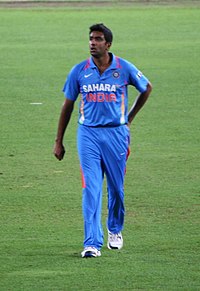
Ashwin has taken a pair of five-wicket hauls in a match on four occasions.
In cricket, a five-wicket haul (also known as a "fifer") refers to a bowler taking five or more wickets in a single innings. This is regarded as a notable achievement, and as of October 2024[update] only 54 bowlers have taken 15 or more five-wicket hauls at international level in their cricketing careers. Ravichandran Ashwin – a right-arm off break bowler – is a Test, One Day International (ODI) and Twenty20 International (T20I) cricketer who represents the India national cricket team. In a 2016 interview, former Sri Lankan cricketer Muttiah Muralitharan described Ashwin as the "best current Test spinner". As of September 2024[update], Ashwin has taken 37 five-wicket hauls in international cricket; he ranks joint-fourth in the all-time list, and joint-first among his countrymen.
Ashwin made his Test debut in November 2011 against the West Indies. He took nine wickets in the match, including a five-wicket haul in the second innings. India won the match and his performance earned him the man of the match honour. His career-best figures of seven wickets for 59 runs came against New Zealand in October 2016; in the process he also became the fifth bowler to take six five-wicket hauls against them. He has picked up ten or more wickets in a match on seven occasions. Ashwin made his ODI and T20I debuts in June 2010 against Sri Lanka and Zimbabwe, respectively, and is yet to take a five-wicket haul in both formats. His four wickets for 25 runs against the United Arab Emirates in the 2015 World Cup remain his best in ODIs, while his figures of four wickets for 8 runs against Sri Lanka are his best in T20Is. (Full article...) -
Image 5
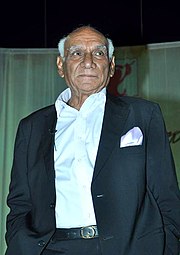
Chopra in 2012
Yash Chopra (1932–2012) was an Indian film director and producer known for his works in Bollywood. Acknowledged as one of the greatest filmmakers from the country, he was credited by the media for "changing the face of romance to become a brand" in the industry. He made his directorial debut with the family drama Dhool Ka Phool, which was produced by his elder brother Baldev Raj. The film, released in 1959, became a commercial success worldwide and gave him critical acclaim. Chopra's next film, Dharmputra (1961), failed to perform well at the box office but won the National Film Award for Best Feature Film in Hindi. In 1965, he directed the drama Waqt about a family who are separated due to a natural disaster. A commercial success, it was one of the earliest Indian films to star an ensemble cast and won a first Best Director trophy for him at the Filmfare Awards.
The 1980s was the most unsuccessful period of his career. Following the failure of his romantic drama Silsila (1981), which he co-wrote, directed and produced, Chopra's popularity began to wane. According to his biographer, the British academic Rachel Dwyer, this was because action and crime films were more popular at the time while most of his films were romances. Chopra experimented with making two action films, Mashaal (1984) and Vijay (1988), which underperformed financially but were well received by critics. Chandni was his only box-office success of the decade. Starring Sridevi in the title role, the film tells the story of a young woman who is accused of being responsible for her lover's accident. Chopra's career began to revive since its premiere in 1989; the film was named the Best Popular Film Providing Wholesome Entertainment at the 37th National Film Awards and considered one of his best films. (Full article...) -
Image 6

Basu at the audio release of Creature 3D
Bipasha Basu is an Indian actress who has featured in over 50 films, predominantly in Hindi language. After a successful career as a model, she made her film debut with a supporting role in Abbas–Mustan's thriller Ajnabee (2001), which won her the Filmfare Award for Best Female Debut. Basu followed this with a role in her first Telugu cinema—the action film Takkari Donga (2002). She had her first major success with the supernatural thriller Raaz (2002), which earned Basu her first Filmfare Award for Best Actress nomination. The following year, she starred opposite John Abraham in the erotic thriller Jism, in which she played a seductive wife. She received a Filmfare Award for Best Performance in a Negative Role nomination for the film. Her roles in these films established her as a sex symbol.
Basu followed this initial success with roles in a series of commercial failures, including the thrillers Aetbaar, Rudraksh, Rakht—all in 2004—and the romance Barsaat (2005). She later featured in Prakash Jha's crime drama Apaharan (2005) and the ensemble comedy No Entry (2005). The latter emerged as a financial success, grossing ₹750 million (US$8.7 million) at the box office, and Basu's role of an escort earned her a nomination for the Best Supporting Actress at the 51st Filmfare Awards. Basu had seven film releases in 2006. Her role as an executive at a conglomerate in Madhur Bhandarkar's drama Corporate earned her another nomination for the Filmfare Award for Best Actress. She then portrayed a character based on Bianca in Vishal Bhardwaj's Omkara, an adaptation of the Shakespearean tragedy Othello. In Sanjay Gadhvi's action film Dhoom 2—her final release of the year—she played dual roles; it was the top-grossing Bollywood film of the year. In 2008, she collaborated with Abbas–Mustan for the second time for Race. Her performance as a troubled wife in Rituparno Ghosh's 2009 Bengali film Shob Charitro Kalponik was critically acclaimed. She then featured in the third installment of the Raaz series, entitled Raaz 3D (2012). Due to her frequent associations with horror films, she was labelled India's "horror queen" by the media. (Full article...) -
Image 7Prithviraj Sukumaran is the recent winner in 2024
The Kerala State Film Award for Best Actor is an award, begun in 1969, presented annually at the Kerala State Film Awards of India to an actor for best performance in a Malayalam film. Until 1997, the awards were managed directly by the Department of Cultural Affairs of the Government of Kerala. Since 1998, the awards have been constituted by the Kerala State Chalachitra Academy, an autonomous, non-profit institution functioning under the Department of Cultural Affairs. The awardees are decided by a jury constituted every year. They are announced by the Minister for Cultural Affairs and are presented by the Chief Minister.
Throughout the years, accounting for ties and repeat winners, the government has presented 54 Best Actor awards to 35 actors. The recipients receive a figurine, a certificate, and a cash prize of ₹100,000 (US$1,200). Several actors have won the honour for more than one film in a given year. As of 2020, the only actor to have won the prize in consecutive years is Bharat Gopy, in 1982 and 1983. (Full article...) -
Image 8

Studio publicity photograph of Bachchan in 2009
Amitabh Bachchan is an Indian actor, playback singer, film producer, television host and former politician who primarily works in Hindi films. He made his acting debut in 1969 with Saat Hindustani, and narrated Mrinal Sen's Bhuvan Shome (1969). He later appeared as Dr. Bhaskar Banerjee in Hrishikesh Mukherjee's Anand (1971), for which he won the Filmfare Award for Best Supporting Actor. In 1973, Bachchan played his breakthrough role of Inspector Vijay Khanna in Prakash Mehra's action film Zanjeer. He has since appeared in several films with the character name "Vijay". During the same year, he appeared in Abhimaan and Namak Haraam. For the latter, he received the Filmfare Award for Best Supporting Actor. He starred along with Shashi Kapoor in Yash Chopra's Deewaar, which earned him widespread critical acclaim and popularity, made him won Filmfare Award for Best Actor nomination. He was cited as the "angry young man" for his roles in Deewaar and Zanjeer. Later he starred in Ramesh Sippy's Sholay (1975), which is considered to be one of the greatest Indian films of all time. After appearing in the romantic drama Kabhie Kabhie (1976), Bachchan starred in Manmohan Desai's highest grosser action-comedy Amar Akbar Anthony (1977). He again won the Filmfare Award for Best Actor for his performance in the latter. He then played dual roles of Don and Vijay in Don (1978), which again earned him the Filmfare Best Actor Award for the consecutive year. All of them were huge blockbusters.
Bachchan's stardom continued to roar in the early 1980s, and his critically and commercially successful ventures in this period include Dostana (1980), Shaan (1980), Ram Balram (1980), Naseeb (1981), Lawaaris (1981), Kaalia (1981), Yaarana (1981), Satte Pe Satta (1982), Namak Halaal (1982), Khud-Daar (1982), Andha Kanoon (1983) and Coolie (1983). His performances in these films in Dostana and Shakti earned him the nominations for the Filmfare Award for Best Actor. He suffered a near-fatal injury while shooting for Coolie. His workload decreased for the upcoming four years (1984–1987), but he found critical and commercial success in Sharaabi (1984), Geraftaar (1985) and Mard (1985). He returned to the screen with the box-office success Shahenshah (1988). A year later, Bachchan played the role of gangster Vijay Deenanath Chauhan in Mukul S. Anand's Agneepath (1990) earned him the National Film Award for Best Actor and later starred in Hum (1991), which was a commercial success. Despite being a box-office failure, the former garnered him the National Film Award for Best Actor and has since developed a cult status. He also earned the Filmfare Award for Best Actor for Hum, following which he took another break from acting. He then played Badshah Khan in Anand's 1992 drama Khuda Gawah, for which he received a civilian award from the President of Afghanistan. Khuda Gawah, released on 8 May 1992, was also a critical and commercial success, and Bachchan's performance was well received both domestically and internationally. In 1996, he started his film production company Amitabh Bachchan Corporation whose first release Tere Mere Sapne (1996) was a box-office hit. Amitabh Bachchan is also known as the "Shahenshah" or "Big B" of Bollywood. (Full article...) -
Image 9
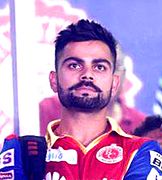
Virat Kohli is the leading century maker, with eight centuries to his name.
In cricket, a batter reaches a century when he scores 100 runs or more in a single innings. A century is regarded as a landmark score for a batter, and his number of centuries is generally recorded in his career statistics. The Indian Premier League (IPL) is a professional league for Twenty20 cricket in India, which has been held annually since its first edition in 2008. Till date, 101 centuries have been scored by 53 different batsmen, out of which 27 are Indian players and 26 are overseas players. Players from 12 of the 15 franchises have scored centuries, with the three franchises that have not had a player score a century for them being Pune Warriors India, Kochi Tuskers Kerala and Gujarat Lions. (Full article...) -
Image 10
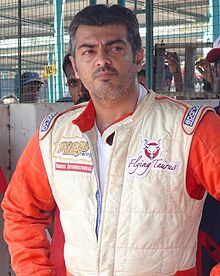
Ajith Kumar in 2010
Ajith Kumar is an Indian actor who works mainly in Tamil cinema. Apart from a small role in the 1990 Tamil film En Veedu En Kanavar, his professional career began three years later with his debut as a lead actor in Tamil cinema with Amaravathi (1993). Despite being a moderate success, the film helped him obtain more modelling assignments. He followed it up the same year with Prema Pusthakam, his only Telugu film to date. After Amaravathi's release, Ajith opted against acting, and instead tried pursuing a career in auto racing. While training for an amateur race, he injured his back and underwent three major surgeries, leaving him bed-ridden for a year and a half. After recovering from the injury, he played supporting roles in Paasamalargal (1994) and Pavithra (1994). After this, he co-starred with Vijay in Rajavin Parvaiyile (1995). That same year, he had his breakthrough with the romantic thriller Aasai. His performance earned him critical acclaim and established him as an up-and-coming actor in Tamil cinema.
He was next seen as the main lead in Agathiyan's epistolary Kadhal Kottai (1996), a critical and commercial success. In 1997, he had five releases, all of which were commercial failures. Ajith's dual portrayal of twin brothers—where one is deaf-mute—in S. J. Suryah's Vaalee (1999) won him his first Filmfare Award for Best Tamil Actor. Impressed with his performance in that film, Rajiv Menon cast Ajith in the ensemble drama Kandukondain Kandukondain (2000) which was also commercial and critical success. The following year, he collaborated with debutant director AR Murugadoss on the action film Dheena. The film was successful in establishing his reputation as an action hero and earning him the nickname "Thala" ("leader"). He earned critical acclaim for his dual role performance in the vigilante film Citizen (2001), and the film was commercial success. and a Best Actor nomination at Filmfare for the drama Poovellam Un Vasam (2001). His last release of the year was Santosh Sivan's Hindi film Aśoka, where he played a brief antagonistic role opposite Shah Rukh Khan. His -role performance as twin brothers in K. S. Ravikumar's film Villain (2002) won him a second Filmfare Award for Best Tamil Actor. (Full article...) -
Image 11

Bhatt at an event for RRR in 2021
Alia Bhatt is a British actress of Indian descent who predominantly works in Hindi films. As a child, she played a minor role in her father Mahesh Bhatt's production Sangharsh (1999), as the younger version of star Preity Zinta's character. In 2012, Bhatt had her first lead role in Karan Johar's teen film Student of the Year, but her performance in it was not well received. Two years later, she gained praise for playing a kidnapping victim in the drama Highway (2014), winning the Filmfare Critics Award for Best Actress. In the same year, her starring roles in the commercially successful romances 2 States and Humpty Sharma Ki Dulhania, both produced under Johar's studio Dharma Productions, established her as a leading actress. She also sang the single "Samjhawan Unplugged" for the latter film's soundtrack.
In Bhatt's three film releases of 2016—Kapoor & Sons, Dear Zindagi, and Udta Punjab—she played young women in troubling circumstances. Her performance in the last of these won her the Filmfare Award for Best Actress. Following another romantic role in Badrinath Ki Dulhania (2017), she played a spy in the thriller Raazi (2018) and a volatile girlfriend in the musical drama Gully Boy (2019). She won two more Best Actress awards at Filmfare for the latter two. This was followed by two poorly received films, Kalank (2019) and Sadak 2 (2020). Bhatt gained further success in 2022 with a brief role in the Telugu period film RRR, and starring roles in the fantasy film Brahmāstra: Part One – Shiva and biopic Gangubai Kathiawadi, in which she starred as the titular prostitute; all three rank among the highest-grossing Indian films of the year. She won the National Film Award for Best Actress and her fourth Best Actress award at Filmfare for the last of these. She also produced and starred in the Netflix black comedy Darlings under her company Eternal Sunshine Productions, for which she received a Filmfare OTT Award. (Full article...) -
Image 12
Tamannaah Bhatia is an Indian actress known for her work in Telugu, Tamil and Hindi cinema. She debuted as a leading lady in the Hindi film Chand Sa Roshan Chehra in 2005. That same year marked her Telugu debut with Sree, followed by her Tamil debut in Kedi the subsequent year. She experienced a breakthrough in her career with the success of Happy Days and Kalloori in 2007, portraying college students in both films. Her journey continued with box-office hits like Ayan, 100% Love, Siruthai, Tadakha, Oosaravelli, Racha and Veeram as well as setbacks such as Ananda Thandavam, Endukante Premanta, Himmatwala, Humshakals and Aagadu. Additionally, while she received critical acclaim and several accolades for her role in 100% Love, her performances in Himmatwala and Humshakals faced criticism.
In 2015, Bhatia received praised for her role in Baahubali: The Beginning, which earned over ₹600 crore. She was praised for her performances in Oopiri and Dharma Durai, and her double role in Devi was well received. However, Vasuvum Saravananum Onna Padichavanga, Bengal Tiger and Kaththi Sandai were less successful. In 2017, she reprised her role in Baahubali 2: The Conclusion, which grossed over ₹1700 crore worldwide, while Anbanavan Asaradhavan Adangadhavan was a box office failure. In 2018, Sketch received mixed reviews, but her performance was praised, while Naa Nuvve and Next Enti? were poorly received. In 2019, she starred in the blockbuster F2: Fun and Frustration and delivered notable performances in Kanne Kalaimaane, Devi 2, Khamoshi, Sye Raa Narasimha Reddy and Petromax. (Full article...) -
Image 13

Trisha Krishnan in 2022
Trisha Krishnan[a] is an Indian actress known for her work mainly in Tamil and Telugu films. She has also acted in Malayalam, Hindi, and Kannada films. She was first seen in 1999 in a minor supporting role in Jodi, then 2000 in the music video of Falguni Pathak's song "Meri Chunar Udd Udd Jaye".
The first project she accepted as a lead actress was Priyadarshan's Lesa Lesa, but a delay in the film's release meant that her first appearance in a lead role was in Ameer's directorial debut Mounam Pesiyadhe in 2002, which was a commercial success.The following year, Trisha appeared as a terminally ill woman in Manasellam, which was a commercial failure. Her next release in 2003 was Hari's action film, Saamy in which she played a soft-spoken Brahmin girl and attracted praise for her performance. The film became a major commercial success, resulting in Trisha receiving new offers, including those from several high-budget productions. Lesa Lesa, which was to have been her debut as a lead actress, was released next. This romantic musical, based on the 1998 Malayalam film Summer in Bethlehem, earned her the ITFA Best New Actress Award. Following Lesa Lesa, she starred in Alai and Enakku 20 Unakku 18 both of which were commercial failures. She made her debut in Telugu cinema in the same year with Tamil-Telugu simultaneously shot movie Enakku 20 Unakku 18 (Nee manasu Naaku Telusu), was also unsuccessful. Trisha's next Telugu release was Varsham in 2004. It was a major success, and won her the Filmfare Best Actress Award (Telugu). It also resulted in her receiving more offers for roles in Telugu films. Later in 2004, Trisha played the role of a damsel in distress where a kabaddi player tries to save from a corrupt politician who wants to marry her in Ghilli. It was a major commercial success. She appeared in Mani Ratnam's political drama Aayutha Ezhuthu (2004), starring as part of an ensemble cast that included Siddharth, R. Madhavan and Suriya. The Telugu romantic comedy Nuvvostanante Nenoddantana (2005) featured Trisha as a village girl and was a commercial success. It earned her another Filmfare Award and her first Nandi Award for Best Actress. She reprised the role in the Tamil remake Unakkum Enakkum (2006) which was also successful. Selvaraghavan's Telugu film Aadavari Matalaku Arthale Verule (2007) the movie was a critical and commercial success won Trisha her third Filmfare Best Actress Award (Telugu). The same year she featured opposite Ajith Kumar in A. L. Vijay's Kireedam was a commercial success. In 2008, her releases Bheemaa and Kuruvi both failed commercially, while Abhiyum Naanum and Krishna earned her Filmfare nominations for Best Actress in the Tamil and Telugu categories respectively. Trisha starred in two films released in 2009: Sarvam and Sankham. The former was commercially unsuccessful, while the latter was critically derided. The following year, she played a Kerala Christian girl in Gautham Vasudev Menon's romance Vinnaithaandi Varuvaayaa (2010). It was a major commercial success and, as well as being a breakthrough film in her career, earned her a Filmfare nomination for Best Actress (Tamil). The same year, she made her Hindi cinema debut with Khatta Meetha (2010). Although a critical and commercial failure, it earned her nomination for a Filmfare Award for Best Female Debut. Her sole Telugu release that year was Namo Venkatesa. Both her 2011 releases –Teen Maar and Mankatha were successful. She had two releases in 2012, Bodyguard (a remake of the same titled Malayalam film) and Dammu were successful. (Full article...) -
Image 14
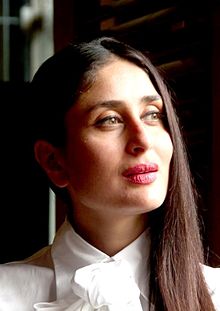
Kapoor Khan at an event for Bajrangi Bhaijaan in 2015
Kareena Kapoor Khan is an Indian actress who has appeared in more than 60 Hindi films. She made her acting debut opposite Abhishek Bachchan in the 2000 drama Refugee, for which she won the Filmfare Award for Best Female Debut. The following year, she appeared in five films, including the romance Mujhe Kucch Kehna Hai, the thriller Ajnabee, and the ensemble melodrama Kabhi Khushi Kabhie Gham.... The latter emerged as the highest-grossing Bollywood film in overseas to that point, and the success of these films established her in Bollywood. This success was followed by repetitive roles in a series of commercial failures.
In 2004, Kapoor portrayed a prostitute in the drama Chameli, which proved to be a turning point in her career, earning her a Filmfare Special Award. That same year, she played a Muslim woman affected by the 2002 Gujarat riots in Govind Nihalani's political drama Dev, and two years later, she played the Desdemona character in Omkara (2006), an adaptation of William Shakespeare's tragedy Othello from director Vishal Bhardwaj. She won two Filmfare Critics Award for Best Actress for these films. In 2007, Kapoor played a loquacious Sikh girl in Jab We Met, a commercially successful romantic comedy co-starring Shahid Kapoor, for which she won the Filmfare Award for Best Actress. (Full article...) -
Image 15

Shetty in 2018
Shilpa Shetty is an Indian actress who is primarily known for her work in Hindi films, in addition to a few Telugu, Kannada and Tamil films. Shetty made her acting debut opposite Shah Rukh Khan in the 1993 thriller Baazigar. Shetty's performance earned her two Filmfare Awards nominations for Lux New Face of the Year and Best Supporting Actress. She subsequently earned recognition with dual roles in the 1994 action-comedy Main Khiladi Tu Anari. After initial success, Shetty's films fared poorly at the box office for the next five years. Films Shetty starred in including action drama Aag, romantic drama Aao Pyaar Karen, comedy Haathkadi and Chhote Sarkar proved to be financially unsuccessful.
The 2000 romantic drama Dhadkan marked a turning point in her career, earning her several nominations in the Best Actress category at various award ceremonies. Shetty played the lead female in films such as family drama Apne, police drama Garv: Pride and Honour and musical drama Life in a... Metro. Her comic performance as an eccentric fisherwoman in 2002 action-drama release Rishtey earned her a nomination for the Filmfare Best Supporting Actress Award. Shetty became a global figure after winning the 2007 British reality television series Celebrity Big Brother, after comments made by other contestants about Shetty fell afoul of Ofcom rules and caused an international controversy over racism. (Full article...) -
Image 16
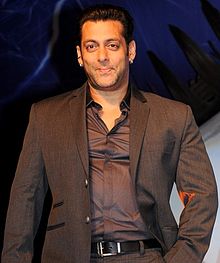
Khan at an event in 2012
Salman Khan is an Indian actor and producer, known for his work in Hindi films. He made his film debut with a brief role in Biwi Ho To Aisi (1988), before having his breakthrough with Sooraj Barjatya's blockbuster romance Maine Pyar Kiya (1989) that won him the Filmfare Award for Best Male Debut. In the early 1990s, he earned success with the action film Baaghi: A Rebel for Love (1990) and the romance Sanam Bewafa, Saajan (both 1991). His other releases during this period failed commercially, resulting in a brief setback in his career.
The success of the family drama Hum Aapke Hain Koun..! (1994) and the melodramatic action Karan Arjun (1995) revitalised Khan's career and established him in Bollywood. Also in 1994, he co-starred with Aamir Khan in the comedy movie Andaz Apna Apna, which was poorly received at that time, but later became a cult film in India. Among his three film releases of 1996 were Sanjay Leela Bhansali's critically acclaimed musical drama Khamoshi and the Raj Kanwar-directed drama Jeet. The following year, he played dual roles in David Dhawan's comedy Judwaa. In 1998, Khan featured in Sohail Khan's Pyaar Kiya To Darna Kya, and appeared briefly in the romantic drama Kuch Kuch Hota Hai, both of which ranked among the top-earning Bollywood productions of 1998. For the latter, he was awarded the Filmfare Award for Best Supporting Actor. (Full article...) -
Image 17Neerja is a 2016 Indian Hindi-language biographical thriller film directed by Ram Madhvani and produced by Atul Kasbekar. The film stars Sonam Kapoor as Neerja Bhanot and features Shekhar Ravjiani, Shabana Azmi and Yogendra Tiku among others in supporting roles. The film's script and screenplay were penned by Saiwyn Quadras, the dialogue was written by Sanyuktha Chawla Sheikh, and the editing was handled by Monisha R Baldawa. Set in Karachi, the plot of Neerja centres on the Libyan-backed Abu Nidal Organization's hijacking of Pan Am Flight 73 in Karachi, Pakistan, on 5 September 1986. The film is shown from the point of view of the flight's head purser, Neerja Bhanot, who died saving passengers on the hijacked flight.
Made on a budget of ₹200 million (US$3.1 million), Neerja was released on 19 February 2016, and grossed ₹1.35 billion (US$16 million) worldwide. The film won 31 awards from 45 nominations; its direction and performances of the cast members have received the most attention from award groups. (Full article...) -
Image 18

The Padma Bhushan is the third-highest civilian award of the Republic of India. Instituted on 2 January 1954, the award is given for "distinguished service of a high order", without distinction of race, occupation, position, or sex. The recipients receive a Sanad, a certificate signed by the President of India and a circular-shaped medallion with no monetary association. The recipients are announced every year on Republic Day (26 January) and registered in The Gazette of India—a publication used for official government notices and released weekly by the Department of Publication, under the Ministry of Urban Development. The conferral of the award is not considered official without its publication in the Gazette. The name of recipient, whose award have been revoked or restored, both of which require the authority of the President, is archived and they are required to surrender their medal when their name is struck from the register; none of the conferments of Padma Bhushan during 1970–1979 have been revoked or restored. The recommendations are received from all the state and the union territory governments, as well as from Ministries of the Government of India, the Bharat Ratna and the Padma Vibhushan awardees, the Institutes of Excellence, the Ministers, the Chief Ministers and the Governors of State, and the Members of Parliament including private individuals.
When instituted in 1954, the Padma Bhushan was classified as "Dusra Varg" (Class II) under the three-tier Padma Vibhushan awards, which were preceded by the Bharat Ratna in hierarchy. On 15 January 1955, the Padma Vibhushan was reclassified into three different awards as the Padma Vibhushan, the Padma Bhushan and the Padma Shri. The criteria included "distinguished service of a high order in any field including service rendered by Government servants", but excluded those working with the public sector undertakings with the exception of doctors and scientists. The 1954 statutes did not allow posthumous awards; this was subsequently modified in the January 1955 statute. The design was also changed to the form that is currently in use; it portrays a circular-shaped toned bronze medallion 1+3⁄4 inches (44 mm) in diameter and 1⁄8 inch (3.2 mm) thick. The centrally placed pattern made of outer lines of a square of 1+3⁄16-inch (30 mm) side is embossed with a knob carved within each of the outer angles of the pattern. A raised circular space of diameter 1+1⁄16 inches (27 mm) is placed at the centre of the decoration. A centrally located lotus flower is embossed on the obverse side of the medal and the text "Padma" is placed above and the text "Bhushan" is placed below the lotus written in Devanagari script. The State Emblem of India is displayed in the centre of the reverse side, together with the national motto of India, "Satyameva Jayate" (Truth alone triumphs) in Devanagari script, which is inscribed on the lower edge. The rim, the edges and all embossing on either side is of standard gold with the text "Padma Bhushan" of gold gilt. The medal is suspended by a pink riband 1+1⁄4 inches (32 mm) in width with a broad white stripe in the middle. It is ranked fifth in the order of precedence of wearing of medals and decorations of the Indian civilian and military awards. (Full article...) -
Image 19

Piku is a 2015 Indian comedy-drama film directed by Shoojit Sircar and produced by N.P. Singh, Ronnie Lahiri and Sneha Rajani. The film stars Deepika Padukone as the eponymous protagonist, alongside Amitabh Bachchan and Irrfan Khan. Moushumi Chatterjee and Jisshu Sengupta play supporting roles. It was written by Juhi Chaturvedi and the musical score was composed by Anupam Roy. Piku tells the story of a headstrong Bengali architect, who along with her hypochondriac father and a helpful businessman embark on a road trip from New Delhi to Kolkata.
Made on an estimated budget of ₹420 million (US$4.9 million), Piku was released on 8 May 2015, and grossed approximately ₹1.41 billion (US$16 million) worldwide. The film garnered awards and nominations in several categories, with particular praise for its writing, music, and the performances of Padukone and Bachchan. As of June 2016, the film has won a minimum of 35 awards. (Full article...) -
Image 20
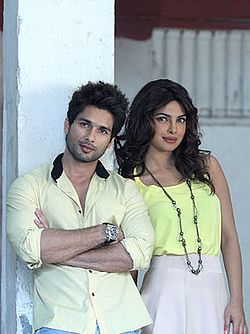
Shahid Kapoor and Priyanka Chopra received several nominations for their respective performances in Kaminey.
Kaminey (English: Rascal) is a 2009 Indian action thriller film directed by Vishal Bhardwaj and produced by Ronnie Screwvala. Shahid Kapoor, Priyanka Chopra, and Amol Gupte star in the lead roles. The film's screenplay was written by Bhardwaj, Abhishek Chaubey, Sabrina Dhawan, and Supratik Sen. Bhardwaj also composed the soundtrack of the film, with lyrics written by Gulzar. Kaminey was edited by A. Sreekar Prasad, and Meghna Manchanda Sen, and the cinematography was provided by Tassaduq Hussain. Set against the backdrop of the Mumbai underworld, the film focuses on the rivalry between identical twin brothers both played by Kapoor, one with a lisp and the other with a stutter, over the course of a single day.
Made on a budget of ₹350 million (US$4.0 million), Kaminey released on 14 August 2009 to critical acclaim and was a commercial success, grossing over ₹710 million (US$8.2 million). The film's soundtrack was also a critical and commercial success, with the song "Dhan Te Nan" topping the charts. Over the years, Kaminey achieved cult status. The film garnered awards and nominations in several categories, with praise for its direction, performance of the cast, screenplay, musical score, cinematography, editing and sound design. (Full article...) -
Image 21

Mohabbatein (transl. Love Stories) is a 2000 Indian Hindi-language musical romantic drama film written and directed by Aditya Chopra. It stars an ensemble cast of Amitabh Bachchan, Shah Rukh Khan, Aishwarya Rai, and the newcomers Uday Chopra, Shamita Shetty, Jugal Hansraj, Kim Sharma, Jimmy Sheirgill, and Preeti Jhangiani. It tells the story of a fictional all-boys college Gurukul's principal Narayan Shankar (Bachchan) who prohibits his students from falling in love and will unhesitantly expel those who do not obey the rule. The rest of the film focuses on how the arrival of the violin teacher Raj Aryan Malhotra (Khan) changes his views. Mohabbatein's soundtrack was composed by Jatin–Lalit, and the lyrics were written by Anand Bakshi. The film was shot by Manmohan Singh on sets designed by Sharmishta Roy, while the editor was V. Karnik.
The film opened at theatres on 27 October 2000 and was met with widespread acclaim from critics, who praised the performances of Bachchan and Khan. Made on a production budget of ₹130 million (US$1.5 million), the film had a total gross of ₹900.1 million (US$10 million) becoming the year's highest-grossing Indian film. (Full article...) -
Image 22

Map shows the ruling parties in states and union territories
In the Republic of India, a chief minister is the head of government of each of the twenty-eight states and three of the eight union territories. According to the Constitution of India, at the state level, the governor is de jure head, but de facto executive authority rests with the chief minister. Following elections to the state legislative assembly, the governor usually invites the party (or coalition) with a majority of seats to form the state government. The governor appoints the chief minister, whose council of ministers are collectively responsible to the assembly. Out of the thirty incumbents, except Tamil Nadu's M. K. Stalin, all other chief ministers also act as the leader of the house in their legislative assemblies. Given they have the assembly's confidence, the chief minister's term is usually for a maximum of five years; there are no limits to the number of terms they can serve.
Two of the incumbents are women — Mamata Banerjee in West Bengal,
who has the longest continuous incumbency serving since 20 March 2011 (for 13 years, 252 days) and Atishi Marlena in Delhi. Atishi (aged 43) is the also the youngest incumbent chief minister, while Kerala's Pinarayi Vijayan (aged 79) is the oldest. Nitish Kumar of Bihar has served for the most terms (nine). Fourteen incumbents belong to the Bharatiya Janata Party, three to the Indian National Congress, and two to the Aam Aadmi Party. No other party has more than one chief minister in office. (Full article...) -
Image 23

Vidya in 2023
Indian actress Vidya Balan made her acting debut in 1995 with the sitcom Hum Paanch, following which she made several unsuccessful attempts at a film career. Vidya then appeared in music videos for Euphoria, Pankaj Udhas, and Shubha Mudgal all directed by Pradeep Sarkar. She had her first film release with a leading role in Goutam Halder's Bengali film Bhalo Theko (2003). In 2005, she starred in Sarkar's Parineeta, an adaptation of Sarat Chandra Chattopadhyay's novel, which won her the Filmfare Award for Best Female Debut. Rajkumar Hirani's Lage Raho Munna Bhai (2006), a successful comedy sequel, saw her play a radio jockey opposite Sanjay Dutt.
Vidya played a variety of roles in 2007, including a woman suffering from multiple sclerosis in Mani Ratnam's drama Guru, a single mother in the comedy Heyy Babyy, and a dissociative identity disorder patient in the thriller Bhool Bhulaiyaa. All three films were commercially successful and established her as a leading lady. This was followed by two commercial failures in 2008. From 2009 to 2012, Vidya starred in five consecutive films that garnered her critical and commercial success. She played the mother of a child afflicted with progeria in Paa (2009), a seductive widow in Ishqiya (2010), and the real-life character of Sabrina Lal in No One Killed Jessica (2011). For portraying the actress Silk in the biopic The Dirty Picture, Vidya won the National Film Award for Best Actress. She next played a pregnant woman seeking revenge in the thriller Kahaani (2012), directed by Sujoy Ghosh. She was awarded the Filmfare Award for Best Actress for her roles in Paa, The Dirty Picture, and Kahaani, and the Filmfare Critics Award for Best Actress for Ishqiya. (Full article...) -
Image 24The 2022 recipient: Neena Gupta
The National Film Award for Best Actress in a Supporting Role (known as National Film Award for Best Supporting Actress prior to 69th NFA) is an honour presented annually at India's National Film Awards ceremony by the National Film Development Corporation of India (NFDC), an organisation set up by the Indian Ministry of Information and Broadcasting. Since 1984, the award is given by a national panel appointed annually by the NFDC to an actress for the best performance in a supporting role within Indian cinema. It is presented by the President of India at a ceremony held in New Delhi. Since the 70th National Film Awards, the name was changed to "Best Actress in a Supporting Role".
The winner is given a "Rajat Kamal" (Silver Lotus) certificate and a cash prize of ₹2,00,000. Including ties and repeat winners, the NFDC has presented a total of 41 Best Supporting Actress awards to 35 different actresses. Although Indian cinema produces films in more than 20 languages, the performances of films that have won awards are of ten languages: Hindi (19 awards), Malayalam (7 awards), Bengali (4 awards), Tamil (4 awards), English (2 awards), Meitei (1 award), Marathi (1 award), Urdu (1 award), Haryanvi (1 award), Odia (1 award). (Full article...) -
Image 25

Priyanka Chopra's performance in Mary Kom garnered her several awards and nominations
Mary Kom is a 2014 Indian biographical sports drama film directed by Omung Kumar and produced by Sanjay Leela Bhansali and Viacom 18 Motion Pictures. The film features Priyanka Chopra in the lead role as the boxer Mary Kom, with Darshan Kumar and Sunil Thapa in supporting roles as her husband and mentor, Onler Kom and M. Narjit Singh respectively. The film was written by Saiwyn Quadras, with the cinematography provided by Keiko Nakahara while Bhansali co-edited the film with Rajesh G. Pandey. The film follows Kom's journey of becoming a boxer to her victory at the 2008 World Boxing Championships in Ningbo, China.
Before its theatrical release on 5 September 2014, the film premiered at the 2014 Toronto International Film Festival, where it became the first Hindi film to be screened on the opening night of the film festival. The film received generally positive reviews from critics and was a commercial success. It grossed ₹1.05 billion (US$12 million) at the box-office against a budget of ₹150 million (US$1.7 million). Mary Kom has received various awards and nominations, with praise for its direction, Chopra's performance, screenplay, editing, background score, and costume design. As of August 2015, the film has won 20 awards. (Full article...)
 Good article – show another
Good article – show another
-
Image 1
The Palamu kila are two ruined forts located 3 k.m from Betla National Park, Latehar district on the bank of Auranga River, in the Indian state of Jharkhand. The old fort in the plains, which existed even before the Chero dynasty, was built by the King of Raksel dynasty. The original fort in the plains and the other on an adjoining hill are attributed to the kings of the Chero dynasty. The fort in the plains had defences on three sides and three main gates. The New fort was constructed by Raja Medini Ray. East India company used this fort to prison Narayan Peshwa of Tiroha and Raja Harsh dubey alias Subedar Aftab Singh mutineers of 1857. (Full article...) -
Image 2Drushyam (transl. Visual) is a 2014 Indian Telugu-language crime thriller film directed by Sripriya and jointly produced by D. Suresh Babu and Rajkumar Sethupathi. It is a remake of Jeethu Joseph's 2013 Malayalam film Drishyam and features Venkatesh, Meena, Esther Anil and Kruthika Jayakumar. Venkatesh and Kruthika plays the respective roles of Mohanlal and Ansiba Hasan in the original whereas Meena and Esther reprises their roles from the original film. The film tells the story of Rambabu, a middle-class cable TV operator, and his family. They come under suspicion when Varun, the son of the Inspector-general of police (IG), goes missing soon after harassing Rambabu's daughter. The rest of the film reveals how Varun disappeared and what Rambabu does to keep his family from going to prison.
The production work of Drushyam was undertaken by Suresh Balaje and George Pious. Music for the film was composed by Sharreth. The cinematography was done by S. Gopal Reddy and the editing by Marthand K. Venkatesh. Principal photography commenced on 8 March 2014 and lasted three months. It was shot primarily in Kerala, similar to the original, and also filmed at Araku, Simhachalam, Vizianagaram and Hyderabad. The post-production phase ended after one month. (Full article...) -
Image 3The Hindu Mela (transl. Hindu fair) was an annual political and cultural festival (mela) that took place in India during the late 19th century. Initially established in 1867 by Nabagopal Mitra, Rajnarayan Basu, and Manomohan Bose as the Chaitra mela, it was intended to establish unity amongst Indians. It was known for promoting sports, indigenous arts and crafts, nationalistic poetry, and songs. The mela met regularly until 1880, after which it lost its importance due to the establishment of other institutions such as the Indian National Congress. (Full article...)
-
Image 4
Genelia Deshmukh, née D'Souza (born 5 August 1987), also credited professionally as Genelia, is an Indian actress who predominantly appears in Telugu, Hindi, and Tamil films. Described in the media as one of the leading South Indian actresses of the 2000s, Genelia has received a Filmfare Award South and two Nandi Awards.
After gaining attention in a Parker Pen commercial with Amitabh Bachchan, D'Souza began her acting career with the Hindi film Tujhe Meri Kasam in 2003. She was recognised for her role in the Tamil film Boys the same year. D'Souza received the Filmfare Award for Best Actress – Telugu for her performance in the romantic comedy Bommarillu (2006). She gave two notable performances in the 2008 romantic comedies Santosh Subramaniam and Jaane Tu... Ya Jaane Na. D'Souza went onto appear in such commercially successful films as Masti (2004), Sye (2004), Sachein (2005), Happy (2006), Dhee (2007), Ready (2008), Katha (2009), Urumi (2011), Force (2011), Velayudham (2011) and Tere Naal Love Ho Gaya (2012). (Full article...) -
Image 5Armaan (transl. Desire) is a 2003 Indian Hindi-language medical drama film that was co-written and directed by Honey Irani. Starring the ensemble cast of Amitabh Bachchan, Anil Kapoor, Preity Zinta, Gracy Singh, and Randhir Kapoor, the film is set in a hospital and follows the travails of its principal, Dr. Akash (Anil Kapoor), to sustain the institution financially. Meanwhile, a mentally unstable woman named Sonia (Zinta) comes into his life and offers to help by donating to the hospital on the condition that Akash marries her.
Irani wrote the story of Armaan and also wrote the screenplay with Javed Akhtar. Principal photography (handled by Ravi Varman) took place in India and Africa, and Shirish Kunder edited the film. It was released on 16 May 2003 and declared a commercial failure, only earning ₹149.2 million (US$1.7 million) against a ₹100 million (US$1.2 million) budget. Although the film garnered mixed reviews, critics praised Irani's direction and the actors' performances, particularly those of Bachchan and Zinta. Zinta received nominations for her performance as the film's antagonist at the Filmfare Awards, the Producers Guild Film Awards, and the Screen Awards. (Full article...) -
Image 6Kumbalangi Nights (transl. Nights of Kumbalangi) is a 2019 Indian Malayalam-language romantic comedy drama film directed by Madhu C. Narayanan. The directorial debut was written by Syam Pushkaran and jointly produced by Fahadh Faasil and Nazriya Nazim under their production house Fahadh Faasil and Friends, in association with Dileesh Pothan and Syam Pushkaran under Working Class Hero. The film stars Soubin Shahir, Shane Nigam, Fahadh Faasil and Sreenath Bhasi, along with debutants Anna Ben, Grace Antony and Mathew Thomas in pivotal roles. The cinematography and editing were handled by Shyju Khalid and Saiju Sreedharan, respectively. The soundtrack and background score is composed by Sushin Shyam.
Set in the eponymous fishing village of Kumbalangi in Kochi, Kerala, the film centres on the strained relationship between four brothers living together in a dysfunctional home, and how they ultimately stand up for each other as a family. Pushkaran came up with the idea for the film based on the time he spent in the village in his twenties. In 2011, he discussed the story with then-assistant director Narayanan, who decided to make his directorial debut with it. By 2016, Faasil and Pothan, both of whom had worked closely with Narayanan and Pushkaran on previous films, had agreed to co-produce the film. Narayanan then spent a year in Kumbalangi to understand its culture better, before shooting began in September 2018. (Full article...) -
Image 7Captain Gurbachan Singh Salaria, PVC (29 November 1935 – 5 December 1961) was an Indian military officer and member of a United Nations peacekeeping force. Salaria was an alumnus of King George's Royal Indian Military College and the National Defence Academy (NDA). He was the first NDA alumnus and is the only UN Peacekeeper to be awarded a Param Vir Chakra (PVC), India's highest wartime military decoration.
In December 1961, Salaria was among the Indian troops deployed to the Republic of the Congo as part of the United Nations Operation in the Congo. On 5 December, as part of Operation Unokat, Salaria's battalion was tasked to clear a roadblock of two armoured cars manned by 150 gendarmes of the secessionist State of Katanga on the way to the Elizabethville Airport. The plan was that Salaria and his men were to block their retreat. His rocket launcher team attacked and destroyed the Katangese armoured cars. This unforeseen move confused the Katangese gendarmes, and Salaria felt it would be best to attack before they reorganised. Though his troops were outnumbered, they charged towards the Katangese and killed 40 men in a kukri assault. During the attack, Salaria was shot twice in the neck and eventually succumbed to his injuries. The remaining gendarmes fled in confusion, leaving their dead and wounded behind. This helped the main battalion to easily overrun the Katangese and clear the roadblock. For his duty and courage, and disregard for his own safety during the battle, Salaria was awarded the PVC. (Full article...) -
Image 8Raja Ravi Varma's lithograph on Mandodari
Mandodari (Sanskrit: मंदोदरी, Mandodarī, lit. "soft-bellied";) was the queen consort of Ravana, the king of Lanka, according to the Hindu epic Ramayana. The Ramayana describes her as beautiful, pious, and righteous. She is extolled as one of the Panchakanya, the recital of whose names is believed to dispel sin.
Mandodari was the daughter of Mayasura, the King of the Asuras (demons), and the apsara (celestial nymphs) Hema. She marries Ravana and bears three sons: Meghanada (Indrajit), Atikaya and Akshayakumara. According to some Ramayana adaptations, Mandodari is also the mother of Rama's wife Sita, who is infamously kidnapped by Ravana. Despite her husband's faults, Mandodari loves him and advises him to follow the path of righteousness. She repeatedly advises Ravana to return Sita to Rama, but her advice falls on deaf ears. Her love and loyalty to Rāvana are praised in the Rāmāyana. (Full article...) -
Image 9
Julia Prinsep Stephen (née Jackson; formerly Duckworth; 7 February 1846 – 5 May 1895) was an English Pre-Raphaelite model and philanthropist. She was the wife of the biographer Leslie Stephen and mother of Virginia Woolf and Vanessa Bell, members of the Bloomsbury Group.
Julia Prinsep Jackson was born in Calcutta to an Anglo-Indian family, and when she was two her mother and her two sisters moved back to England. She became the favourite model of her aunt, the celebrated photographer Julia Margaret Cameron, who made more than 50 portraits of her. Through another maternal aunt, she became a frequent visitor at Little Holland House, then home to an important literary and artistic circle, and came to the attention of a number of Pre-Raphaelite painters who portrayed her in their work. (Full article...) -
Image 10Dil Chahta Hai (transl. The Heart Desires) is a 2001 Indian Hindi-language comedy-drama film written and directed by Farhan Akhtar in his directoral debut. It was produced by Ritesh Sidhwani and released under the banner of Excel Entertainment (which Akhtar and Sidhwani co-founded), marking their cinematic debut. The film focuses on a significant transition period in the lives of three college-graduate friends (Aamir Khan, Saif Ali Khan and Akshaye Khanna). It also stars Preity Zinta, Sonali Kulkarni and Dimple Kapadia.
Dil Chahta Hai was based on Akhtar's diary detailing his trips to Mumbai and New York City, and a story by a friend of his, Kassim Jagmagia, who would ultimately become a creative associate at Excel Entertainment. He started writing the screenplay in 1998 but finished it when the film's principal photography was started two years later. The film was produced on a budget of ₹80 million (US$920,000), and filming took place in both India and Australia. It was one of the first films shot in sync sound, with Nakul Kamte and H. Sridhar handling its sound recording. The trio Shankar–Ehsaan–Loy, with lyrics penned by Akhtar's father, Javed Akhtar, composed the soundtrack and the background score. (Full article...) -
Image 11Muthu (transl. Pearl) is a 1995 Indian Tamil-language masala film written and directed by K. S. Ravikumar, and produced by Kavithalayaa Productions. The film stars Rajinikanth and Meena, with Sarath Babu, Radha Ravi, Senthil, Vadivelu, Jayabharathi, Subhashri and Ponnambalam all acting in supporting roles. It is a remake of the Malayalam film Thenmavin Kombath (1994). The film revolves around a zamindar and his worker falling in love with the same woman who, unknown to the zamindar, loves the worker exclusively.
After Rajinikanth narrated the outline of Thenmavin Kombath, he told Ravikumar to develop the screenplay of the remake without watching the original film. Although largely written to suit the tastes of Tamil-speaking audiences, the remake retains the core premise of the original, while adding new plot details and characters. Ashok Rajan acted as the film's cinematographer. Principal photography began in June 1995 and took place in Mysore, Madras and Kerala. The film was edited by K. Thanikachalam and the music composed by A. R. Rahman, with lyrics written by Vairamuthu. (Full article...) -
Image 12

The 1960 North Indian Ocean cyclone season featured two deadly tropical cyclones that collectively killed approximately 20,000 people collectively in East Pakistan (present-day Bangladesh). The Indian subcontinent divides the North Indian Ocean into two areas: the Bay of Bengal to the east and the Arabian Sea to the west. The official Regional Specialized Meteorological Centre for this basin is the India Meteorological Department (IMD), while the Joint Typhoon Warning Center releases unofficial advisories. On average, five storms form in the North Indian Ocean every season with dual peaks in activity during May and November. Cyclones that occurred between 45°E and 100°E were included in seasonal records by the IMD.
Fifteen depressions developed during the 1960 season, with five becoming cyclonic storms. The majority of the activity took place in the Bay of Bengal, where eleven systems formed; however, the season's first storm formed over the Arabian Sea on May 10. The storm produced hurricane-force winds and attained a barometric air pressure of 974 mbar (hPa; 28.76 inHg). The deadliest and most intense cyclone of the season was Severe Cyclonic Storm Ten, which killed 14,174 in East Pakistan in early November. With peak winds estimated at 150 km/h (95 mph) and a pressure of 966.7 mbar (hPa; 28.55 inHg), it struck just three weeks after the previous system devastated the same area. The storm produced a 6.1 m (20 ft) storm tide that swept 16 km (10 mi) inland, submerging several small islands. The two storms left a combined 200,000–300,000 people homeless. These systems marked the start of an unusually active period of cyclones impacting East Pakistan, culminating ten years later with the 1970 Bhola cyclone, which killed between 300,000 and 500,000 people. During the 1960 season, several depressions impacted India with heavy rainfall. Collectively, these systems killed 167 people. (Full article...) -
Image 13Jain temples on Shatrunjaya hill near Palitana, Gujarat
Jainism (/ˈdʒeɪnɪzəm/ JAY-niz-əm), also known as Jain Dharma, is an Indian religion. Jainism traces its spiritual ideas and history through the succession of twenty-four tirthankaras (supreme preachers of Dharma), with the first in the current time cycle being Rishabhadeva, who lived millions of years ago, the twenty-third tirthankara Parshvanatha, whom historians date to the 9th century BCE, and the twenty-fourth tirthankara Mahavira, around 600 BCE. Jainism is considered an eternal dharma with the tirthankaras guiding every time cycle of the cosmology. Each individual soul possesses boundless bliss and infinite knowledge which is obscured due to its misidentification with the body. Therefore, central to understanding Jain philosophy is the concept of bhedvigyān, or the clear distinction in the nature of the soul and non-soul entities. This principle underscores the innate purity and potential for liberation within every soul, distinct from the physical and mental elements that bind it to the cycle of birth and rebirth. Recognizing and internalizing this separation is essential for spiritual progress and the attainment of samyak darshan or self realization (atma-anubhuti), which marks the beginning of the aspirant soul's journey towards liberation. The three main pillars of Jainism are ahiṃsā (non-violence), anekāntavāda (non-absolutism), and aparigraha (non-possessiveness).
Jain monks take five main vows: ahiṃsā (non-violence), satya (truth), asteya (not stealing), brahmacharya (chastity), and aparigraha (non-possessiveness). These principles have affected Jain culture in many ways, such as leading to a predominantly lacto-vegetarian lifestyle. Parasparopagraho jīvānām (the function of souls is to help one another) is the faith's motto, and the Namokar Mantra is its most common and strongest prayer. (Full article...) -
Image 14From the photo spread in The Statesman on 22 August 1943 showing famine conditions in Calcutta. These photographs made world headlines and spurred government action.
The Bengal famine of 1943 was a famine in the Bengal province of British India (present-day Bangladesh, West Bengal and eastern India) during World War II. An estimated 800,000–3.8 million people died, in the Bengal region (present-day Bangladesh and West Bengal), from starvation, malaria and other diseases aggravated by malnutrition, population displacement, unsanitary conditions, poor British wartime policies and lack of health care. Millions were impoverished as the crisis overwhelmed large segments of the economy and catastrophically disrupted the social fabric. Eventually, families disintegrated; men sold their small farms and left home to look for work or to join the British Indian Army, and women and children became homeless migrants, often travelling to Calcutta or other large cities in search of organised relief.
Bengal's economy had been predominantly agrarian at that time, with between half and three-quarters of the rural poor subsisting in a "semi-starved condition". Stagnant agricultural productivity and a stable land base were unable to cope with a rapidly increasing population, resulting in both long-term decline in per capita availability of rice and growing numbers of the land-poor and landless labourers. A high proportion laboured beneath a chronic and spiralling cycle of debt that ended in debt bondage and the loss of their landholdings due to land grabbing. (Full article...) -
Image 15Koi... Mil Gaya (Hindi pronunciation: [ˈkoːi mɪl ɡəjaː] transl. Someone...Is Found) is a 2003 Indian science fiction action-drama film directed and produced by Rakesh Roshan. It stars Hrithik Roshan, Preity Zinta and Rekha. In addition to writing the story, Rakesh Roshan also wrote the screenplay with Sachin Bhowmick, Honey Irani, and Robin Bhatt. Koi... Mil Gaya focuses on Rohit Mehra, a developmentally disabled man who contacts an extraterrestrial being later named Jadoo with his late father Sanjay's supercomputer. The film follows his relationship with Nisha, Rohit's friend, who falls in love with him.
After the release of the commercially and critically successful romantic film Kaho Naa... Pyaar Hai (2000), Roshan wanted to work again with his son Hrithik on a different type of film. In June 2001, during the 2nd IIFA Awards, he announced the second film when he received the Best Director award for Kaho Naa... Pyaar Hai. Principal photography was shot by Ravi K. Chandran and Sameer Arya from November 2001 to March 2003 on sets built by Sharmishta Roy in Canada, India, and New Zealand. Roshan's brother, Rajesh Roshan, composed the film's soundtrack and background score. American artists Mark Clobe and Craig Mumma spent ₹4 crore (US$460,000) on its visual effects. (Full article...) -
Image 16
Uttar Pradesh (/ˌʊtər prəˈdɛʃ/ UUT-ər prə-DESH; Hindi: [ˈʊtːəɾ pɾəˈdeːʃ]; abbr. UP) is a state in northern India. With over 241 million inhabitants, it is the most populated state in India as well as the most populous country subdivision in the world – more populous than all but four other countries outside of India (China, US, Indonesia, and Pakistan) – and accounting for 16.5 percent of the population of India or around 3 percent of the total world population. The state is bordered by Rajasthan to the west, Haryana, Himachal Pradesh and Delhi to the northwest, Uttarakhand and Nepal to the north, Bihar to the east, Madhya Pradesh, Chhattisgarh and Jharkhand to the south. It is the fourth-largest Indian state by area covering 243,286 km2 (93,933 sq mi), accounting for 7.3 percent of the total area of India. Lucknow serves as the state capital, with Prayagraj being the judicial capital. It is divided into 18 divisions and 75 districts.
Uttar Pradesh was established in 1950 after India had become a republic. It is a successor to the United Provinces, established in 1935 by renaming the United Provinces of Agra and Oudh, in turn established in 1902 from the North-Western Provinces and the Oudh Province. Though long known for sugar production, the state's economy is now dominated by the services industry. The service sector comprises travel and tourism, hotel industry, real estate, insurance and financial consultancies. The economy of Uttar Pradesh is the third-largest state economy in India, with ₹18.63 lakh crore (US$220 billion) in gross domestic product and a per capita GSDP of ₹68,810 (US$800). The High Court of the state is located in Prayagraj. The state contributes 80 seats to the lower house Lok Sabha and 31 seats and the upper house Rajya Sabha. (Full article...) -
Image 17Riflemen of the 48th Highlanders of Canada take cover during German counterattack north of San Leonardo, 10 December 1943.
The Moro River campaign was an important battle of the Italian campaign during the Second World War, fought between elements of the British Eighth Army and LXXVI Panzer Corps (LXXVI Panzerkorps) of the German 10th Army (10. Armee). Lasting from 4 December 1943 to 4 January 1944, the campaign occurred primarily in the vicinity of the Moro River in eastern Italy. The campaign was designed as part of an offensive launched by General Sir Harold Alexander's Allied 15th Army Group, with the intention of breaching the German Army's Winter Line defensive system and advancing to Pescara—and eventually Rome.
Beginning on 4 December, four infantry divisions—one British, one Canadian, one Indian and one New Zealand (which included an armoured brigade)—and two armoured brigades (one British and one Canadian) of V Corps and XIII Corps attacked heavily defended German positions along the Moro River, achieving several exploitable bridgeheads by 8 December. Throughout the next week, nearly continuous combat operations by both sides—designed to keep one another pinned down—created stagnated defensive positions near Orsogna and a narrow pit known as "The Gully". After being held at the Gully for 10 days, the Canadians succeeded in outflanking German defences, and forcing a German withdrawal to the Ortona–Orsogna Line. On 20 December, the line was attacked by both corps. (Full article...) -
Image 18Chennai Express is a 2013 Indian Hindi-language action comedy film directed by Rohit Shetty and produced by UTV Motion Pictures and Red Chillies Entertainment. It stars Shah Rukh Khan, Deepika Padukone and with Nikitin Dheer and Sathyaraj in supporting roles. The film revolves around Rahul Mithaiwala, a businessman who accidentally boards the eponymous train and journeys from Mumbai to Rameswaram with the daughter of an influential crimeboss.
The first planned collaboration between Khan and Shetty was a remake of Angoor (1982). The script of Chennai Express, which was initially written as a backup project for Khan, was chosen instead. Conceived as a "commercial romance", the film was originally titled Ready Steady Po. Filming began in Mehboob Studio in October 2012 and was completed by May 2013. A large part of the film was set in Ooty, for which sets were constructed in Wai and also in Ramoji Film City. The soundtrack for Chennai Express was composed by Vishal–Shekhar, with the background score being composed by Amar Mohile. UTV Motion Pictures came on board as producer and distributor, marking its first active project with Khan after Swades (2004). (Full article...) -
Image 19
The gharial (Gavialis gangeticus), also known as gavial or fish-eating crocodile, is a crocodilian in the family Gavialidae and among the longest of all living crocodilians. Mature females are 2.6 to 4.5 m (8 ft 6 in to 14 ft 9 in) long, and males 3 to 6 m (9 ft 10 in to 19 ft 8 in). Adult males have a distinct boss at the end of the snout, which resembles an earthenware pot known as a ghara, hence the name "gharial". The gharial is well adapted to catching fish because of its long, narrow snout and 110 sharp, interlocking teeth.
The gharial probably evolved in the northern Indian subcontinent. Fossil gharial remains were excavated in Pliocene deposits in the Sivalik Hills and the Narmada River valley. It currently inhabits rivers in the plains of the northern part of the Indian subcontinent. It is the most thoroughly aquatic crocodilian, and leaves the water only for basking and building nests on moist sandbanks. Adults mate at the end of the cold season. Females congregate in spring to dig nests, in which they lay 20–95 eggs. They guard the nests and the young, which hatch before the onset of the monsoon. The hatchlings stay and forage in shallow water during their first year, but move to sites with deeper water as they grow. (Full article...) -
Image 20Jalaluddin enthroned as Sultan of Delhi
The Khalji Revolution, alternatively spelled the Khilji Revolution, marked a military coup and a period of political and societal transformation in the Delhi Sultanate. It unfolded following the death of the Mamluk sultan Balban and the subsequent incapacity of his successors to effectively govern the Delhi Sultanate. The upheaval commenced and concluded in 1290 when Jalaluddin Khalji seized absolute power, defeating the Turkic nobility and toppling the Mamluks, inaugurating the rule of the Khalji dynasty.
After Balban's death, his underage grandson Qaiqabad ascended the throne. A poor governor, Qaiqabad later fell ill and became paralyzed, leading to the succession of his son, Shamsuddin Kayumars. Amidst this upheaval, two factions arose within the Mamluk court, with the Turkic element led by Aitmar Surkah facing off against Jalaluddin Khalji's group. (Full article...) -
Image 21
Air India Express Flight 812 was a scheduled international flight from Dubai International Airport, Dubai to Mangalore International Airport, Mangalore. On 22 May 2010, the Boeing 737-800 passenger jet operating the flight crashed on landing at Mangalore. The captain had continued an unstabilised approach, despite three calls from the first officer to initiate a "go-around", resulting in the aircraft overshooting the runway, falling down a hillside, and bursting into flames. Of the 166 passengers and crew on board, 158 were killed (all 6 crew members and 152 passengers); only eight survived. This was the first fatal accident involving Air India Express and, as of 2025, the deadliest. (Full article...) -
Image 22Rudraveena (lit. 'Strings of fury'; referring to the instrument of the same name) is a 1988 Indian Telugu-language musical-drama film directed and co-written by K. Balachander. Produced by Nagendra Babu's Anjana Productions, the film stars Chiranjeevi alongside Tamil actor Gemini Ganesan (in his only appearance in Telugu cinema) and Shobana. It also marked the acting debut of Kannada actor and filmmaker Ramesh Aravind in Telugu cinema. P. L. Narayana, Prasad Babu, Sumithra, Devilalitha, and Brahmanandam play supporting roles.
Rudraveena focuses on the ideological conflicts between 'Bilahari' Ganapathi Sastry, a reputed carnatic musician and his younger son Suryanarayana "Suryam" Sastry. Sastry's discrimination towards the people belonging to lower castes is criticised by his son, Suryam, who believes in society's welfare and walks out for good later. The events that led to the change in Sastry's views form the remaining part of the story. Ganesh Patro wrote the film's dialogue and worked on the script with Balachander for two months, though it was tweaked many times during the shoot. Ilaiyaraaja composed the soundtrack and background score. R. Raghunadha Reddy was the director of photography. Ganesh Kumar edited the film and Mohanam was the art director. (Full article...) -
Image 23

The Mumbai Mirror is an Indian English-language newspaper published in Mumbai, Maharashtra. Launched in 2005 as a compact daily newspaper, its coverage focused on city specific local news and civic issues concerning education, healthcare and municipal administration. The founding editor of the paper was Meenal Baghel who is credited for developing an aggressive public service oriented editorial outlook for the paper that it had till its downsizing in 2020. In 2017, it had a readership of over 1.8 million which made it the fifth most widely read English language newspaper in the country.
The newspaper is owned by The Times Group, the publisher of The Times of India. It was launched as part of a ringfencing tactic against competitors in the city of Mumbai. The paper's growth in circulation and positive editorial reception inspired the creation of other city specific newspapers such as the Bangalore Mirror, Pune Mirror and Ahmedabad Mirror. (Full article...) -
Image 24
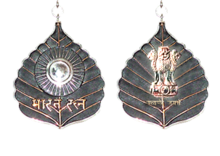
The Bharat Ratna (Hindi pronunciation: [bʱaːɾət̪ ɾət̪n̪ə]; lit. 'Jewel of India') is the highest civilian award of the Republic of India. Instituted on 2 January 1954, the award is conferred in recognition of "exceptional service/performance of the highest order", without distinction of race, occupation, position or gender. The award was originally limited to achievements in the arts, literature, science, and public services, but the Government of India expanded the criteria to include "any field of human endeavor" in December 2011. The recommendations for the award are made by the Prime Minister to the President. The recipients receive a Sanad (certificate) signed by the President and a peepal leaf-shaped medallion. Bharat Ratna recipients rank seventh in the Indian order of precedence.
The first recipients of the Bharat Ratna were: the former Governor-General of the Union of India C. Rajagopalachari, the former President of the Republic of India Sarvepalli Radhakrishnan; and the Indian physicist C. V. Raman, who were honoured in 1954. Since then, the award has been bestowed upon 53 individuals, including 18 who were awarded posthumously. The original statutes did not provide for posthumous awards but were amended in January 1966 to permit them to honor former Prime Minister Lal Bahadur Shastri, the first individual to be honored posthumously. In 2014, cricketer Sachin Tendulkar, then aged 40, became the youngest recipient, while social reformer Dhondo Keshav Karve was the oldest recipient when he was awarded on his 100th birthday. Though usually conferred on India-born citizens, the award has been conferred on one naturalized citizen, Mother Teresa, and on two non-Indians: Abdul Ghaffar Khan (born in British India and later a citizen of Pakistan) and Nelson Mandela, a citizen of South Africa. (Full article...) -
Image 25Hichki (pronounced [ɦɪtʃʰkɪ]; transl. Hiccup) is a 2018 Indian Hindi-language comedy drama film co-written and directed by Siddharth P. Malhotra and produced by Aditya Chopra and Maneesh Sharma under the former's banner of Yash Raj Films. Based on American motivational speaker Brad Cohen's autobiography Front of the Class, it stars Rani Mukerji in her comeback appearance as Naina Mathur, an aspiring teacher who was rejected by many schools because of her Tourette syndrome until she is accepted at the St. Notker's School, her alma mater. She is assigned to teach students from a nearby slum in the class 9F, which was created by the Government of India to fill a quota for the underprivileged.
Malhotra struggled to find a studio to finance Hichki, since the film, which had begun scripting in 2013 after he acquired the rights to Front of the Class, was felt to lack potential for the box office. Chopra and Sharma later insisted on producing Hichki with Malhotra as director. Principal photography was handled by Avinash Arun and took place in Mumbai between April and June 2017, with Meenal Agarwal as the art director and Vaibhavi Merchant providing the choreography. The film was edited by Shweta Venkat Matthew. Jasleen Royal and Hitesh Sonik composed the soundtrack and background score, respectively. (Full article...)
News
- 22 January 2025 – 2025 Jalgaon train accident
- At least thirteen people are killed in a railway accident in Jalgaon, Maharashtra, India. The victims had initially fled from their train following an alleged fire alarm and were subsequently struck and killed by a passing train on the adjacent tracks. (BBC)
- 20 January 2025 – 2024 Kolkata rape and murder
- A court in Kolkata, India, sentences a 33-year-old police volunteer to life in prison for raping and murdering a medical trainee in August 2024. (DW)
- 17 January 2025 – Naxalite–Maoist insurgency
- Twelve Naxalites are killed in a police raid in Bijapur, Chhattisgarh, India. (Al Jazeera)
- 16 January 2025 – 2025 in spaceflight
- The twin satellites SDX01 and SDX02 of the SpaDeX mission, launched in December by the Indian Space Research Organisation, successfully conduct India's first spacecraft docking, with India becoming the fourth country to successfully dock a spacecraft after the United States, Russia, and China. (BBC News)
- 11 January 2025 – 2024–25 South-West Indian Ocean cyclone season
- France places the Indian Ocean island of Mayotte on red alert due to approaching Tropical Cyclone Dikeledi, roughly one month after the French overseas department was devastated by Cyclone Chido. (Reuters)
Did you know...
- ... that the Indian director Manhar Raskapur's films Mulu Manek and Kadu Makrani were both remade during the 1970s?
- ... that a painting by the artist Bichitr shows an Indian emperor preferring a Sufi saint over the king of England and the Ottoman sultan?
- ... that Amrita Sher-Gil's painting Hill Women appeared on a 1978 Indian postage stamp?
- ... that a judge is threatening to shut down Wikipedia in India over a defamation lawsuit?
- ... that of the 146 Conestoga wagons employed by the Braddock Expedition in the French and Indian War, only one remained intact by the campaign's end?
- ... that when visiting Britain during World War II, naval officer Kalyani Sen reported that Indian women were breaking down prejudices against men and women working together by joining the military?
Topics related to India
Timeline of Indian history, Indus Valley Civilisation, Dholavira, Science and technology in ancient India, Meluhha, Aryan invasion theory, Out of India theory, Greek conquests in India, Indian maritime history, Maurya Empire, Ashoka, Shunga Empire, Hoysala Empire, Vijayanagara, Satavahana dynasty, Indo-Greek Kingdom, Indo-Scythians, Indo-Parthian Kingdom, Kushan Empire, Western Satraps, Gupta Empire, Chola dynasty, Pala Empire, Islamic incursions in India, Mughal Empire, Maratha Empire, British Raj, East India Company, Governor-General, Viceroy, War of Independence, 1857, Indian independence movement, Indian National Army, Azad Hind, Quit India Movement, Partition of India, History of Republic of India, Non-Aligned Movement, Sino-Indian War, Indo-Pakistani War of 1947–1948, Indo-Pakistani War of 1965, Indo-Pakistani War of 1971, Kargil War, 2001–02 India–Pakistan standoff, Military, Demographic
Law, Hindu law, Constitution, Political parties (Indian National Congress, Bharatiya Janata Party), Foreign relations, Elections, Political divisions, Reservation in India
Government agencies, Legislative branch (Lok Sabha, Rajya Sabha) Executive branch (President & Vice President, Prime Minister & Deputy Prime Minister, Cabinet Ministers, Cabinet Secretary, Election Commission, Foreign Minister; Law enforcement: CBI, CID, Intelligence: IB, RAW), Directorate General of Income Tax Investigation Judicial branch (Supreme Court), Armed Forces (Army, Navy, Air Force, Border Security Force, Coast Guard)
Himalayas, Western Ghats, Eastern Ghats, Indo-Gangetic Plain, Deccan Plateau, Thar Desert, Ganges, Rann of Kutch, Brahmaputra River, Northeast India; Mountains, Valleys, Islands, Rivers; States and union territories, Cities, Districts, Regions, Fauna, Flora
Rupee, Bombay Stock Exchange, National Stock Exchange, Standard of living, Companies, Reserve Bank of India, Energy policy (Solar, Wind, Nuclear), Tourism, Transport (Expressways, Rail transport, Auto rickshaw),
Languages, Standard of living, Religion
Music (Carnatic, Hindustani, Indi-pop), Dance, Languages, Literature, Architecture, Film & TV, Cuisine, Holidays, Folklore, Education, Media, Indian martial arts
Indian Council of Agricultural Research (ICAR), Indian Institute of Astrophysics, National Centre for Software Technology, AIIMS, IISc, IIT, NIT, BITS-Pilani, INRegistry, Indian numbering system, Indian Space Research Organisation, National Internet Exchange of India, ICRISAT, International Institute of Information Technology, Hyderabad
Indian English, Indian nationality law, Numbering system, Indian Space Research Organisation, Telecommunications, National Highways Development Project, Flag, Vehicle registration plates, Indian nationalism, Metrication in India
Categories
Related portals
Religions in India
Indian Subcontinent
Other countries
Wikipedias in Indian languages
- অসমীয়া (Assamese)
- বাংলা (Bengali)
- भोजपुरी (Bhojpuri)
- বিষ্ণুপ্রিয়া মণিপুরী (Bishnupriya Manipuri)
- गोंयची कोंकणी / Gõychi Konknni (Konkani)
- ગુજરાતી (Gujarati)
- हिन्दी (Hindi)
- ಕನ್ನಡ (Kannada)
- कॉशुर/كشميري (Kashmiri)
- मैथिली (Maithili)
- മലയാളം (Malayalam)
- मराठी (Marathi)
- नेपाली (Nepali)
- नेपाल भाषा
- (Newari)
- ଓଡ଼ିଆ (Odiya)
- ਪੰਜਾਬੀ (Punjabi)
- पालि (Pali)
- संस्कृत (Sanskrit)
- ᱥᱟᱱᱛᱟᱲᱤ (Santali)
- سنڌي (Sindhi)
- தமிழ் (Tamil)
- తెలుగు (Telugu)
- ತುಳು (Tulu)
- اردو (Urdu)
Associated Wikimedia
The following Wikimedia Foundation sister projects provide more on this subject:
-
Commons
Free media repository -
Wikibooks
Free textbooks and manuals -
Wikidata
Free knowledge base -
Wikinews
Free-content news -
Wikiquote
Collection of quotations -
Wikisource
Free-content library -
Wikiversity
Free learning tools -
Wikivoyage
Free travel guide -
Wiktionary
Dictionary and thesaurus
- ^ In this Indian name, the name Krishnan is a patronymic, and the person should be referred to by the given name, Trisha.
- Pages using the Phonos extension
- Pages with Hindustani IPA
- Pages including recorded pronunciations
- Pages with Tamil IPA
- Pages with non-numeric formatnum arguments
- Pages with Hindi IPA
- Portals with triaged subpages from June 2018
- All portals with triaged subpages
- Portals with no named maintainer
- Automated article-slideshow portals with 51–100 articles in article list
- Automated article-slideshow portals with 101–200 articles in article list
- Automated article-slideshow portals with 501–1000 articles in article list
- Wikipedia move-protected portals
- Redirect targets of redirected portals with existing subpages








